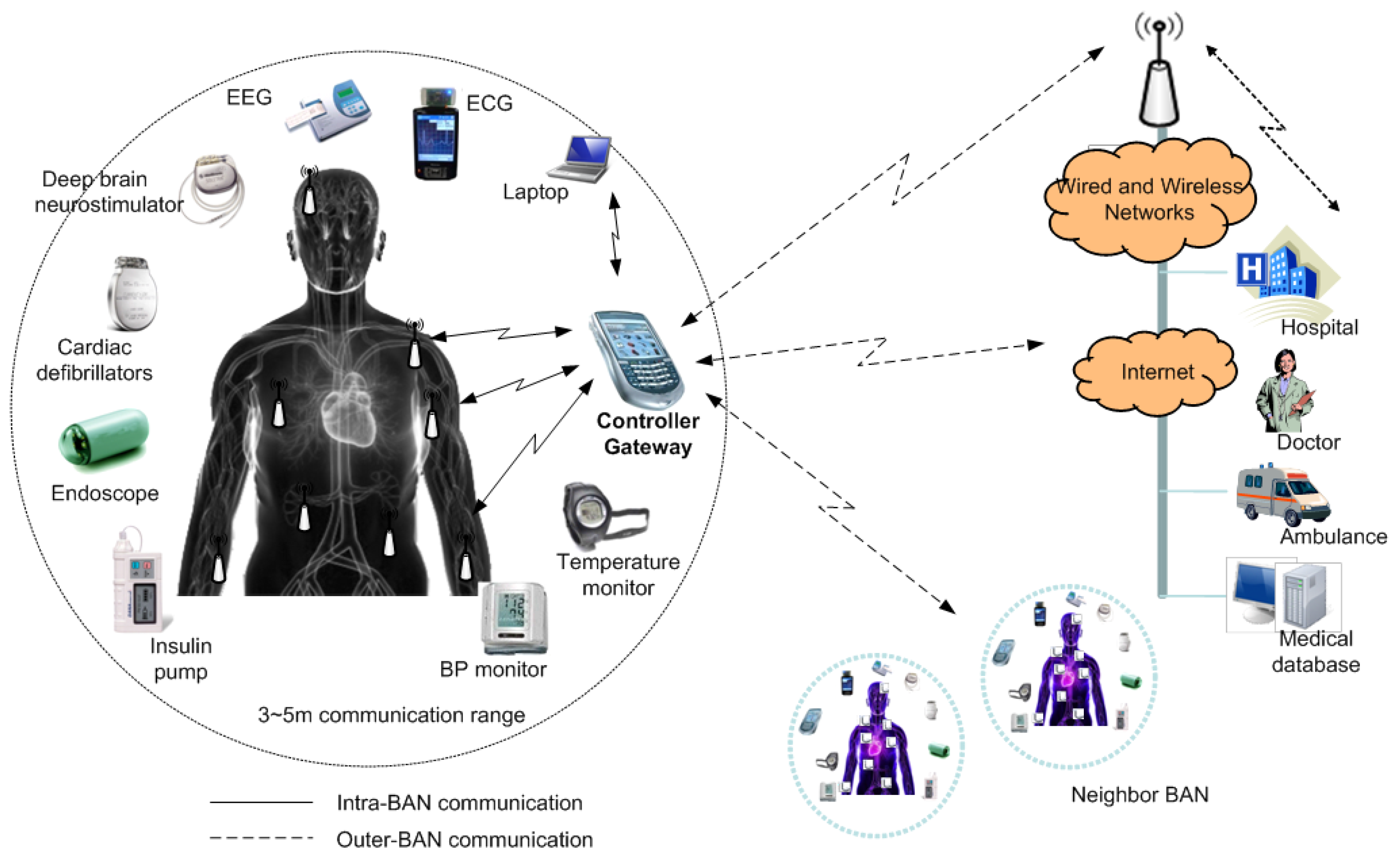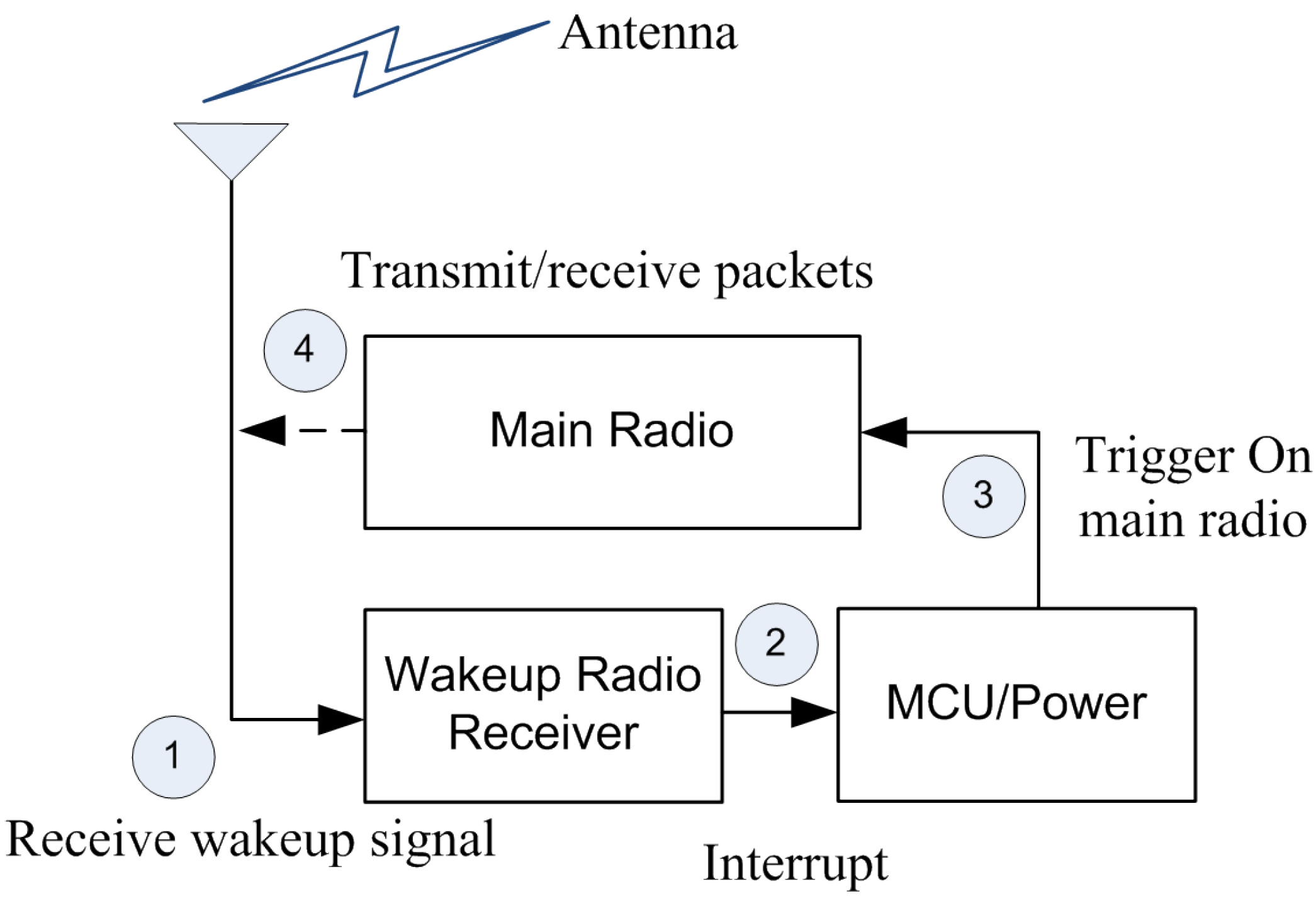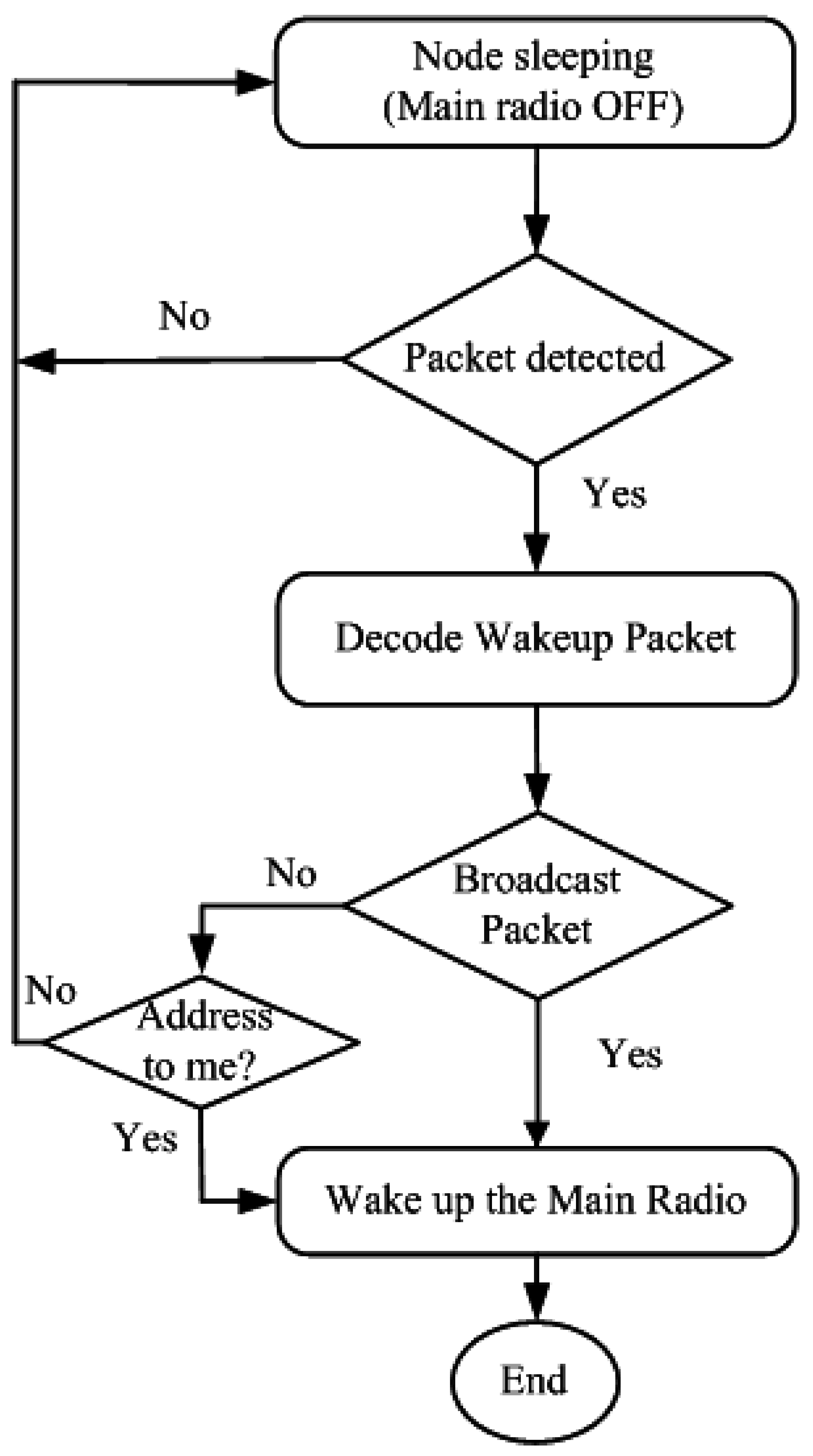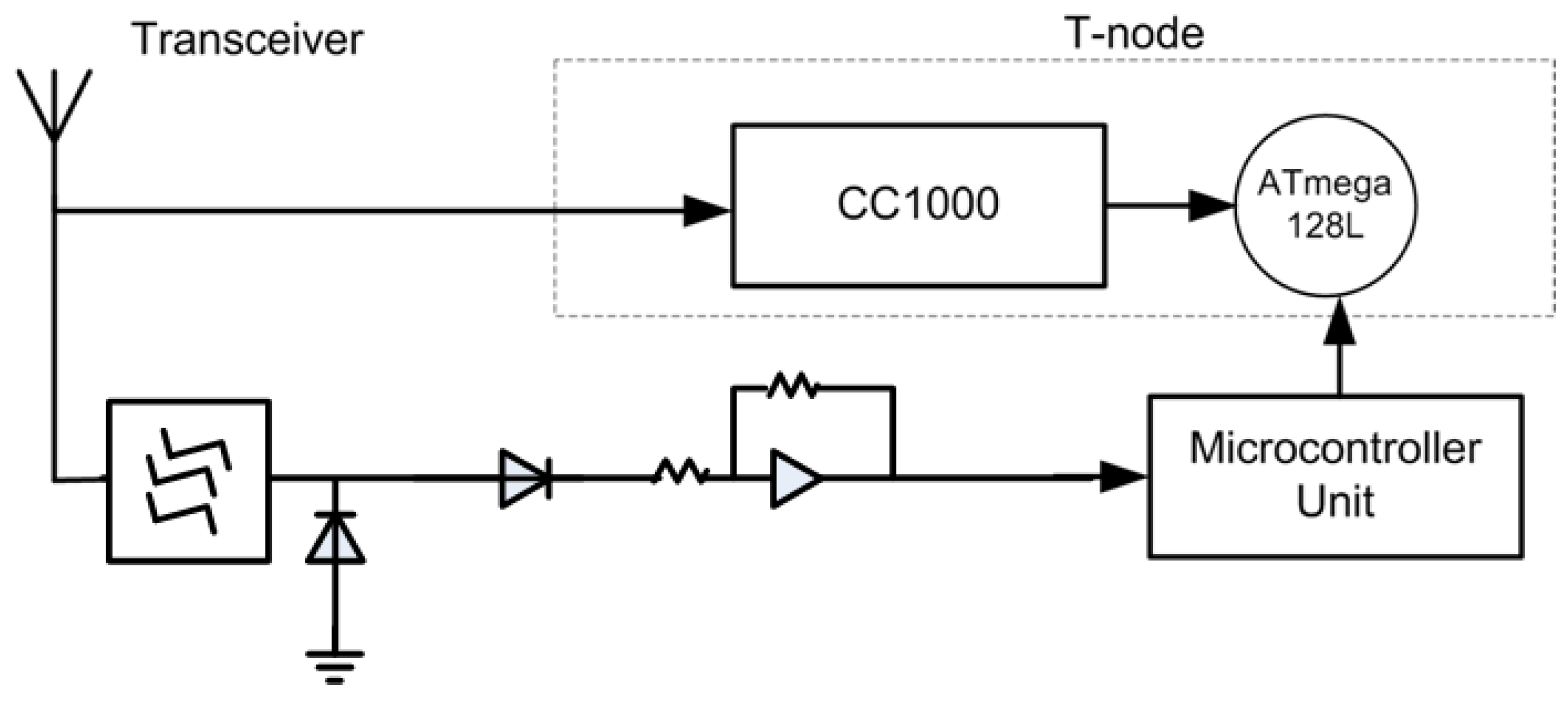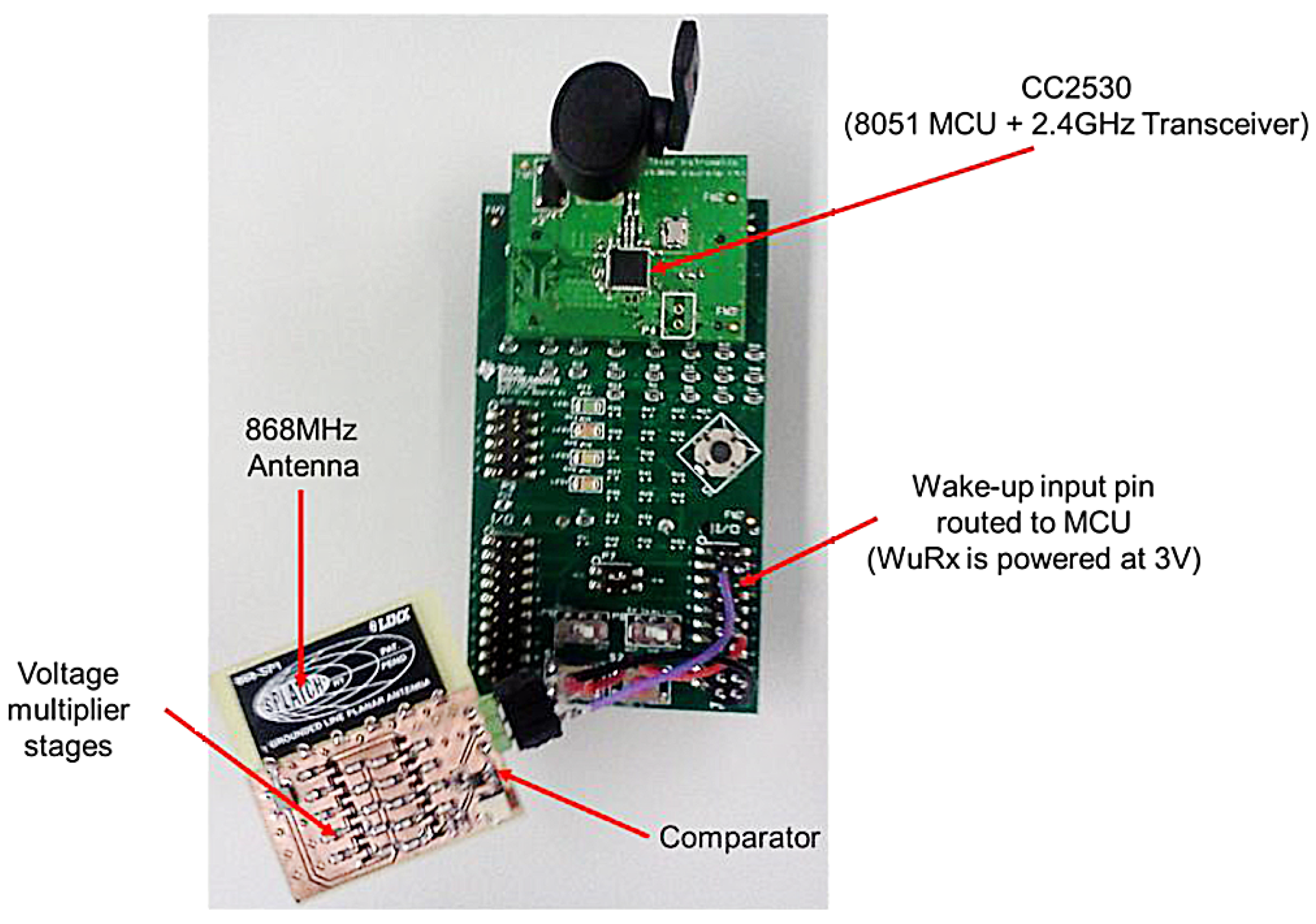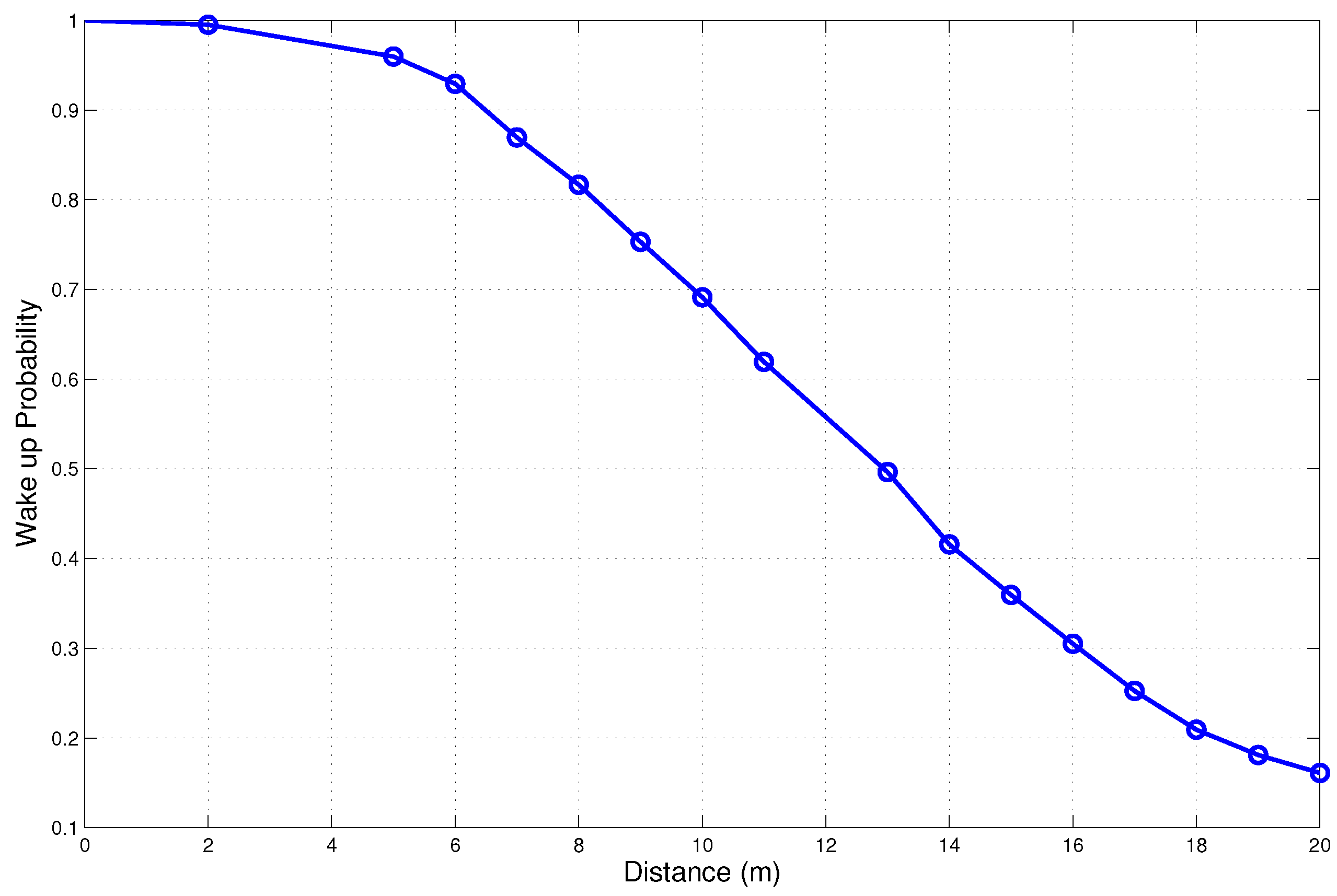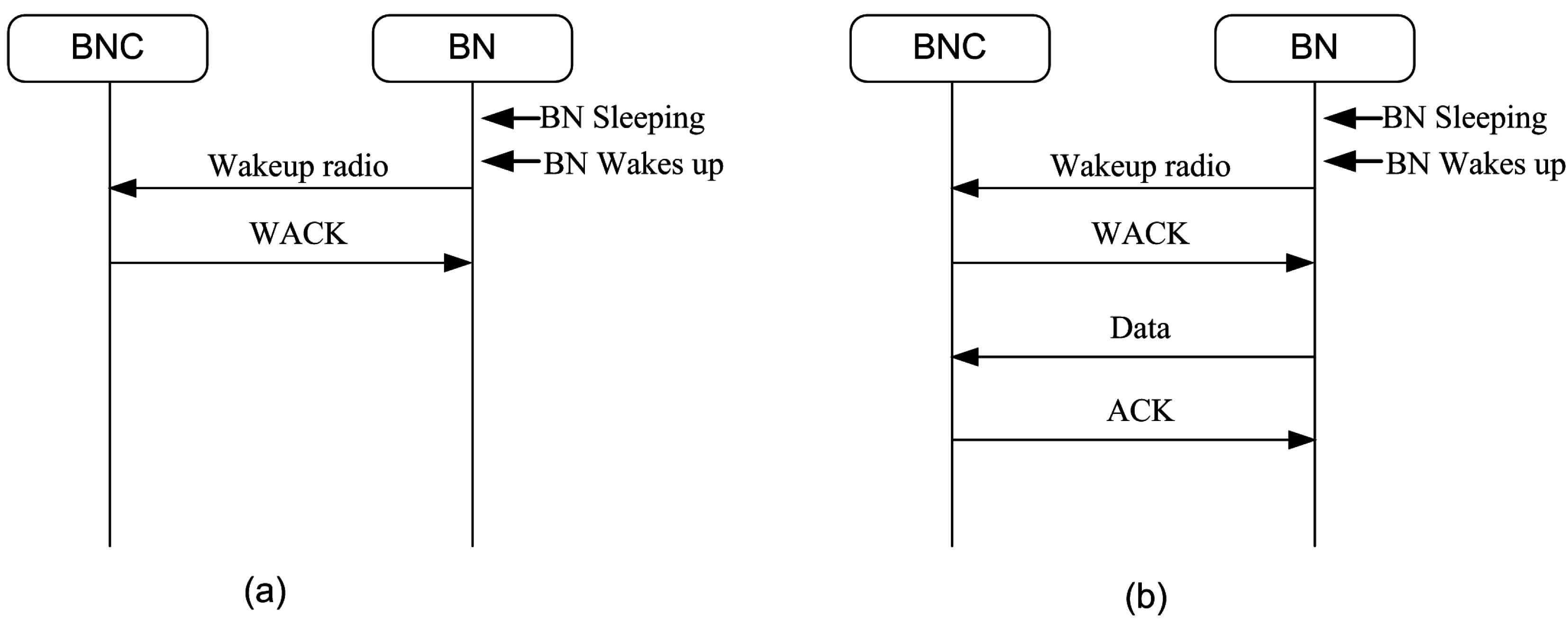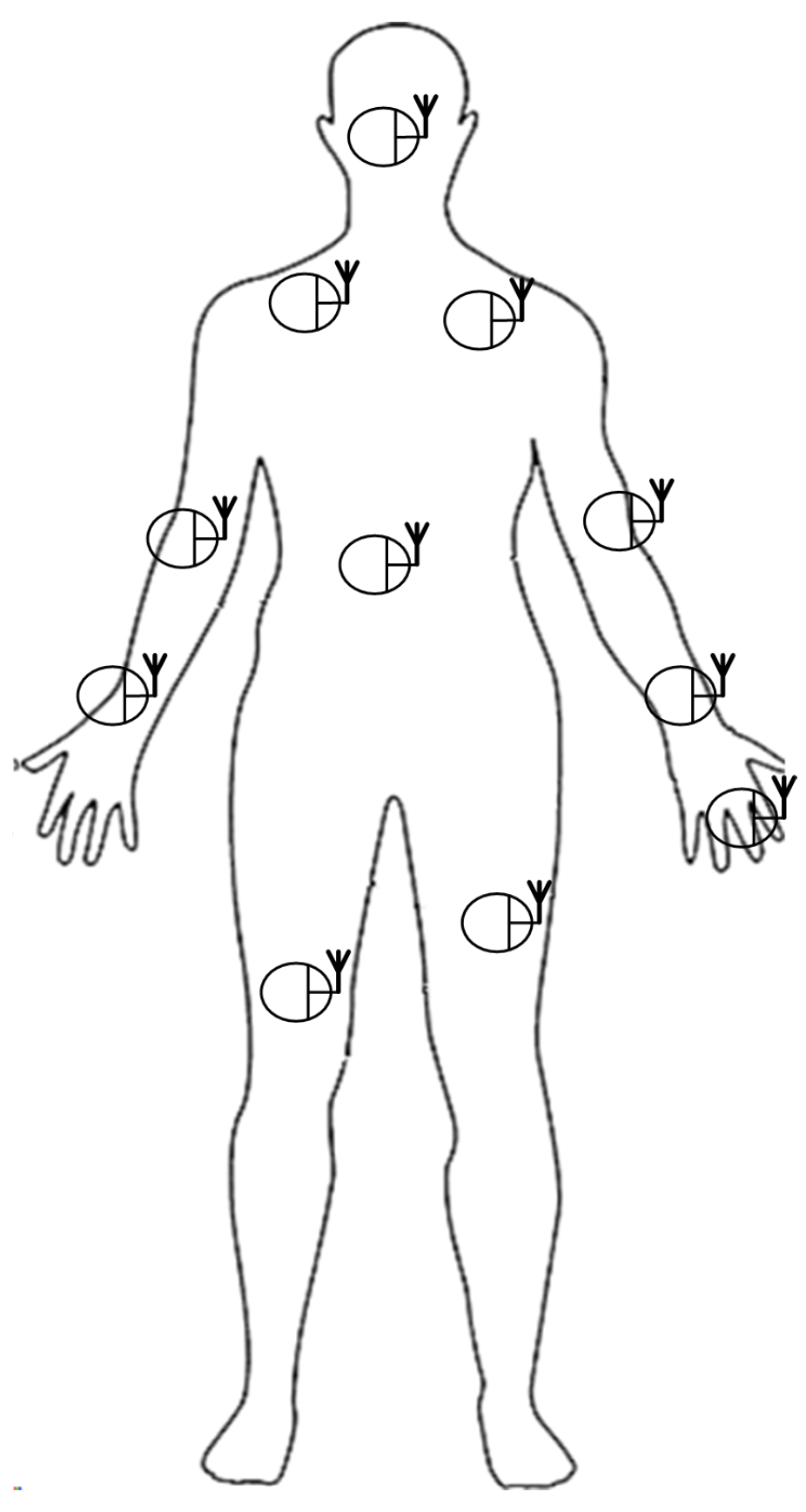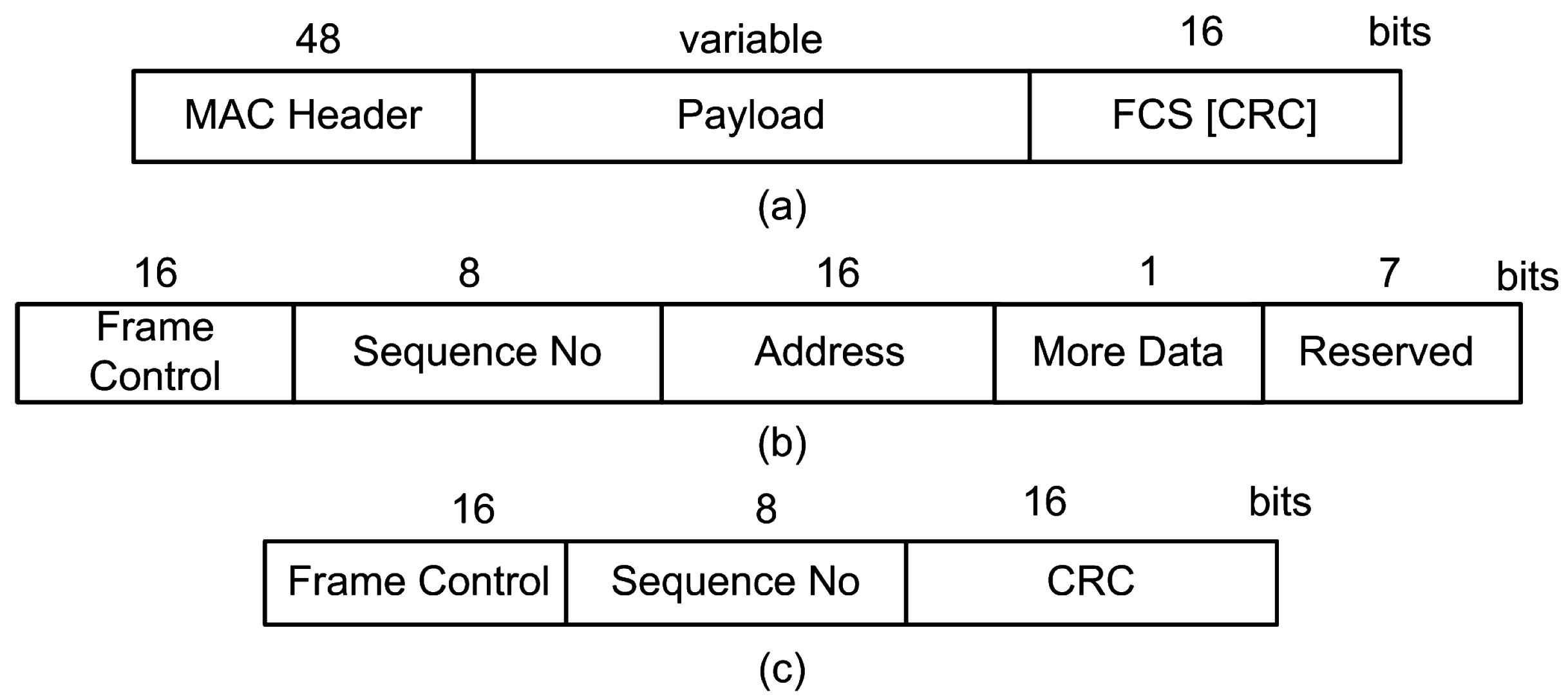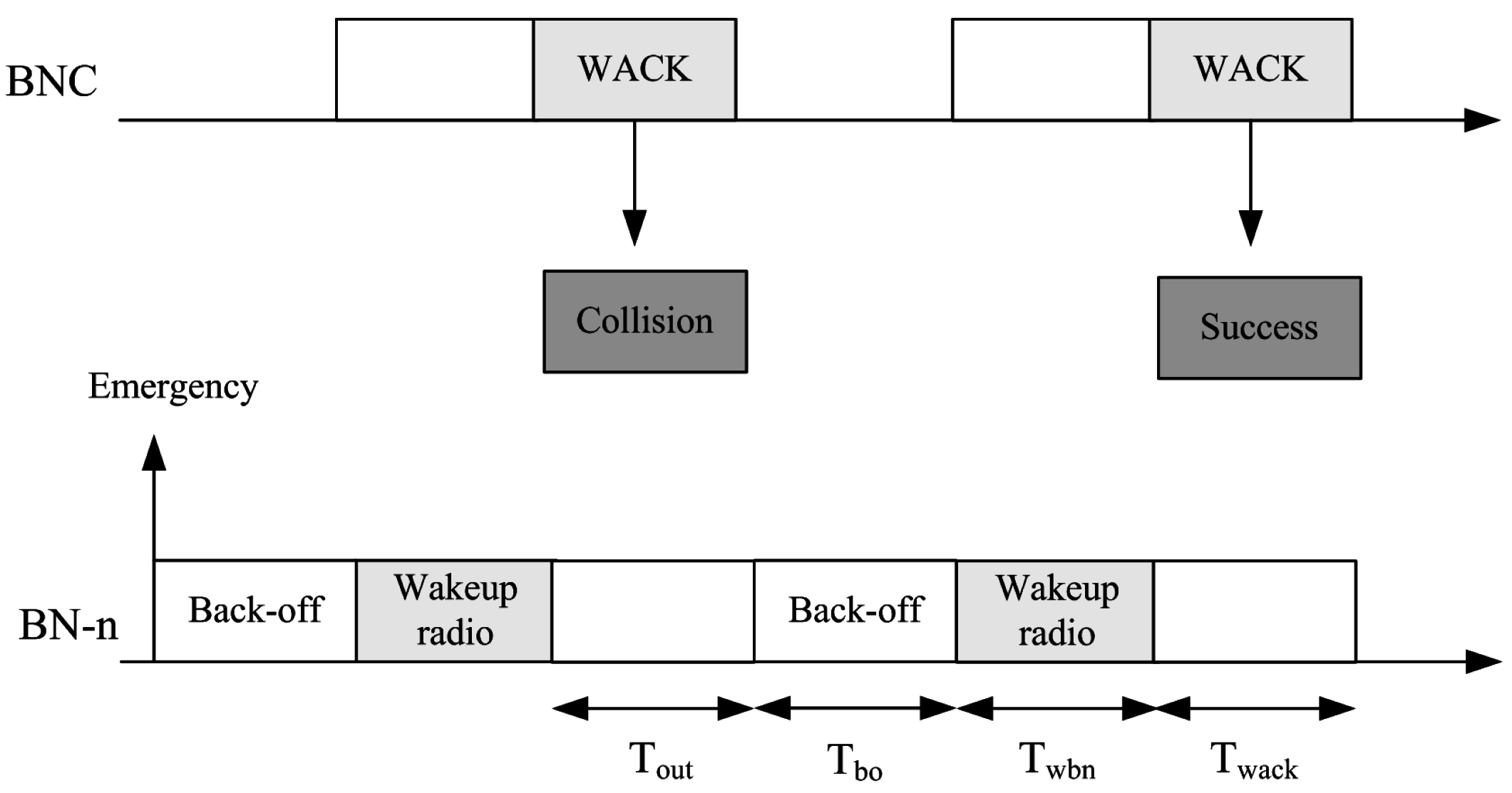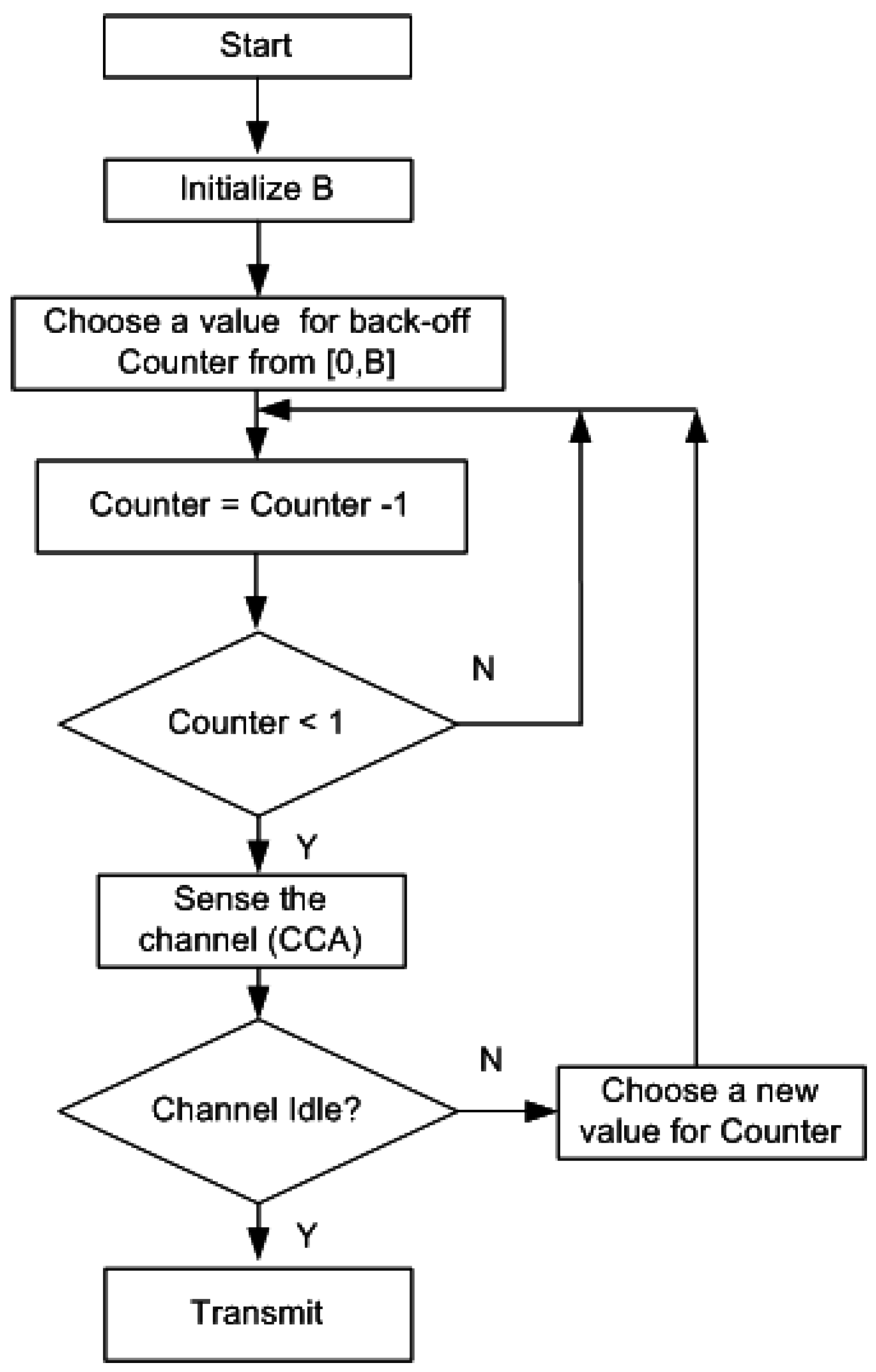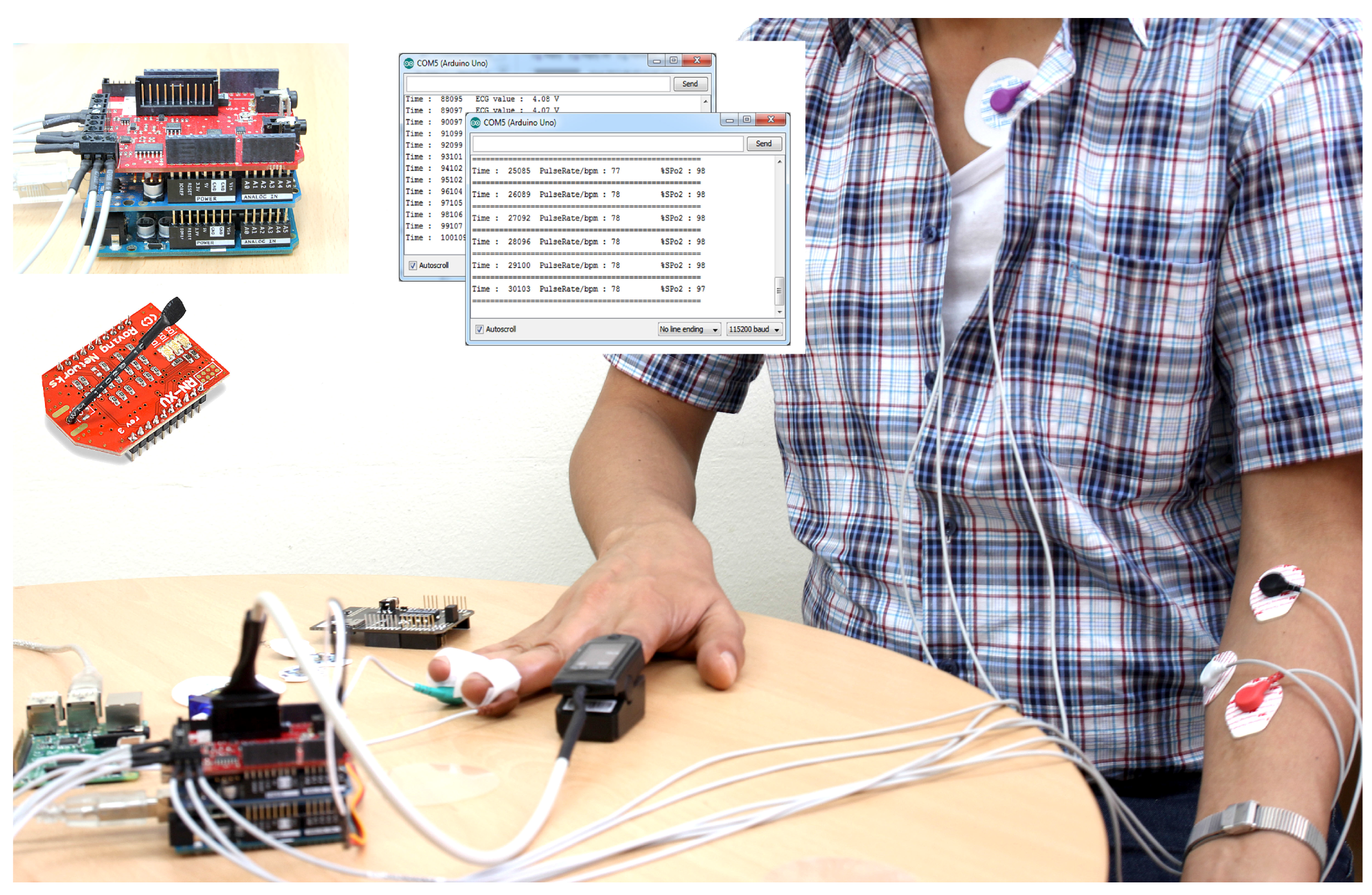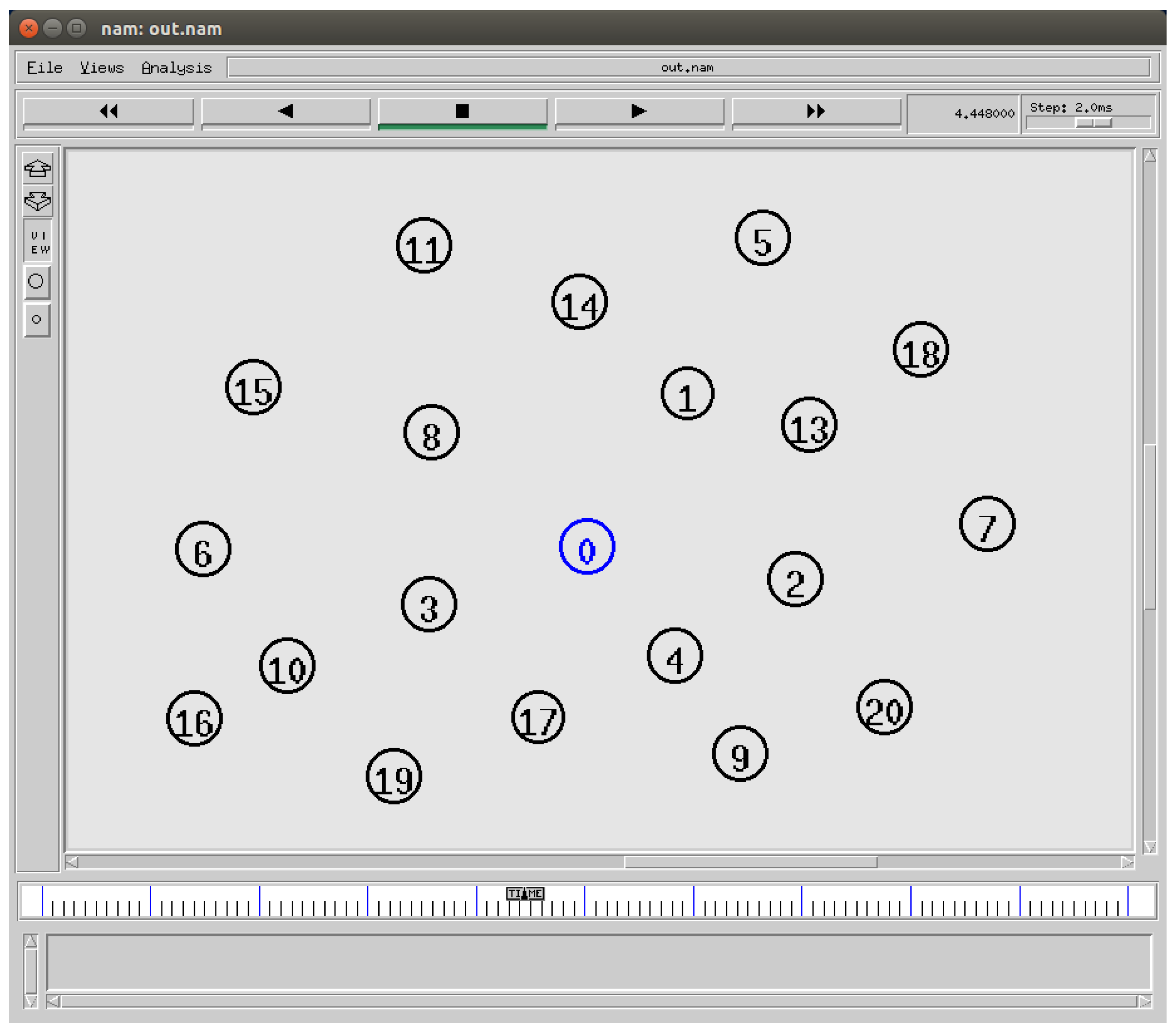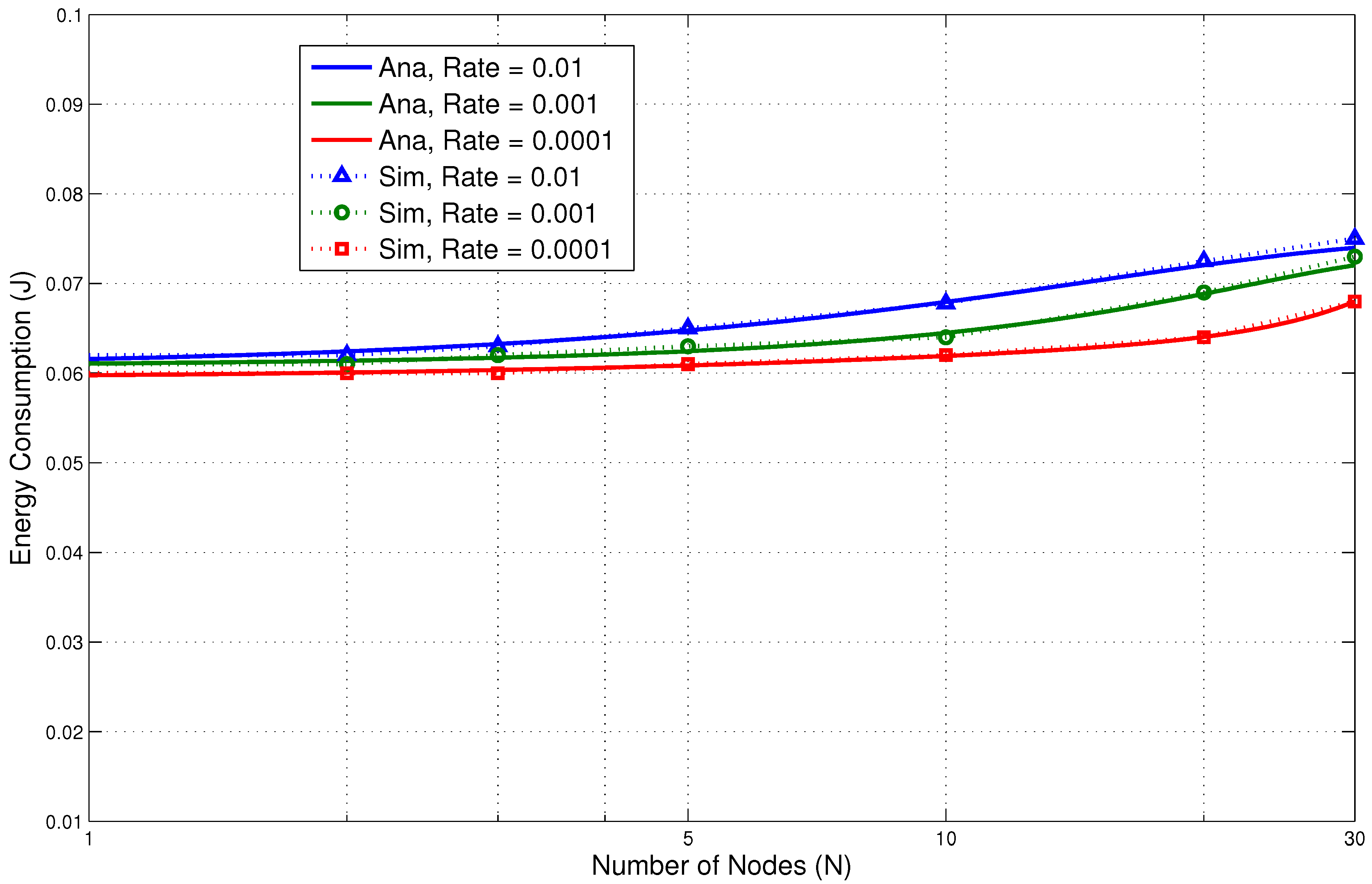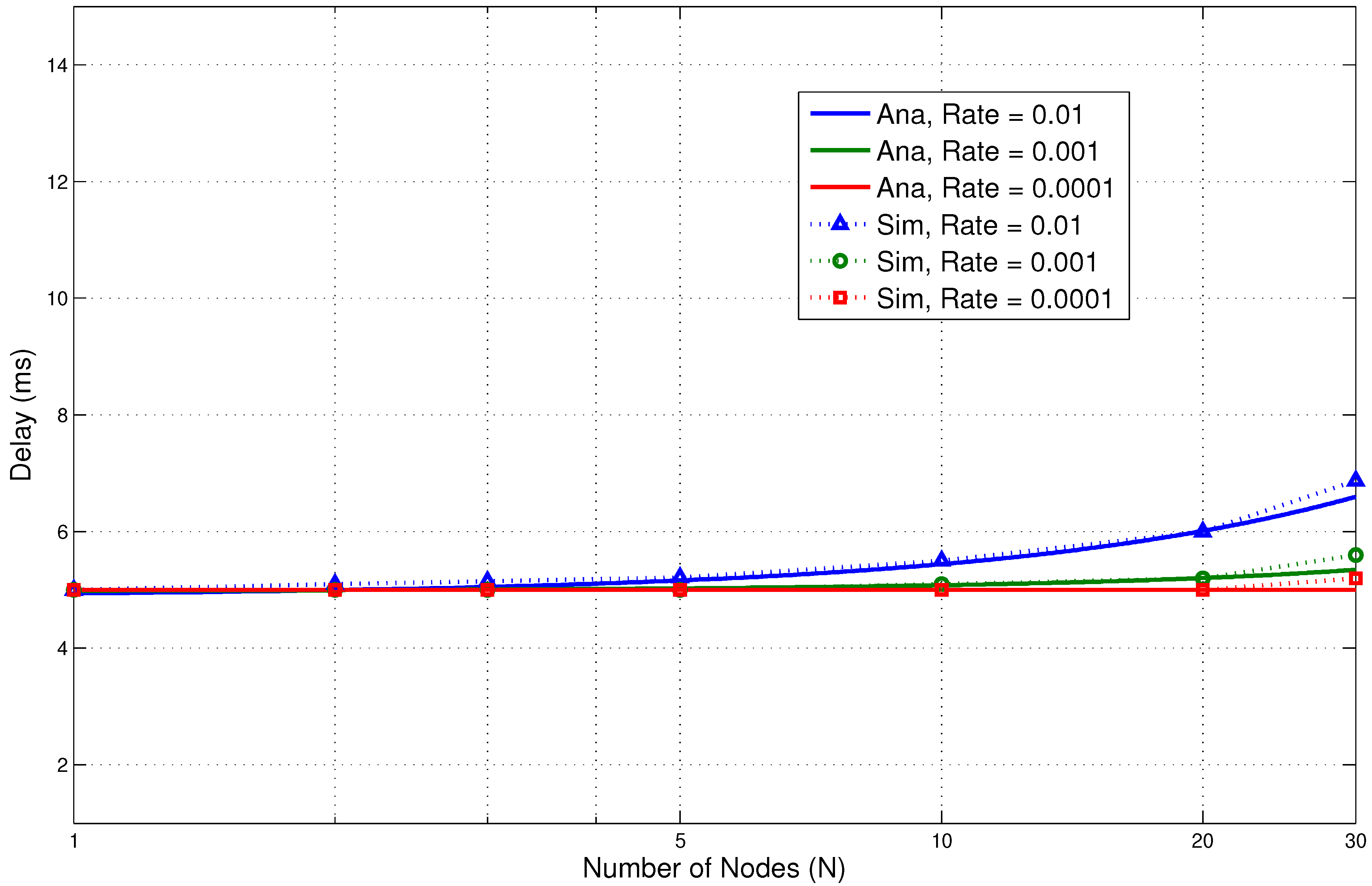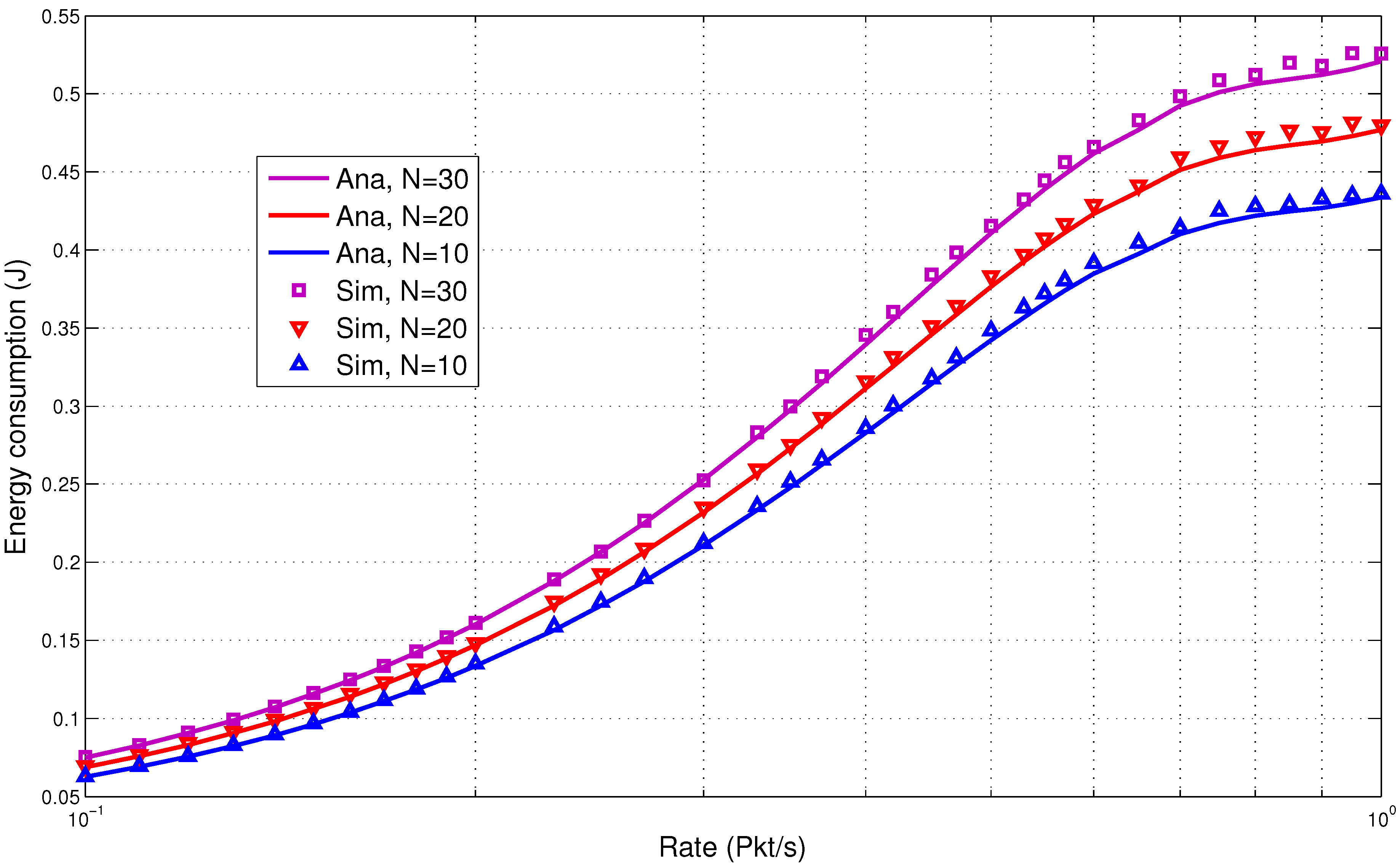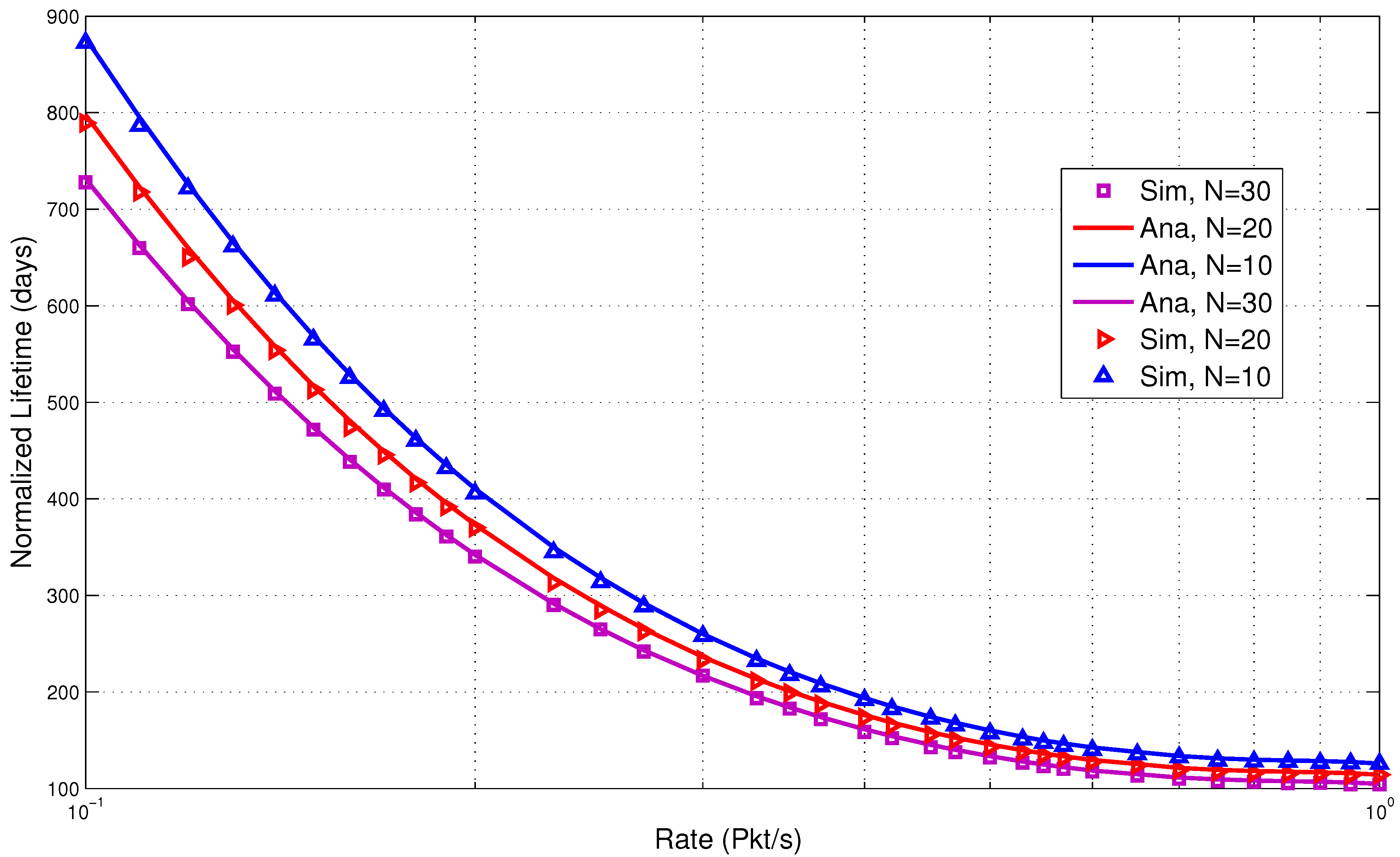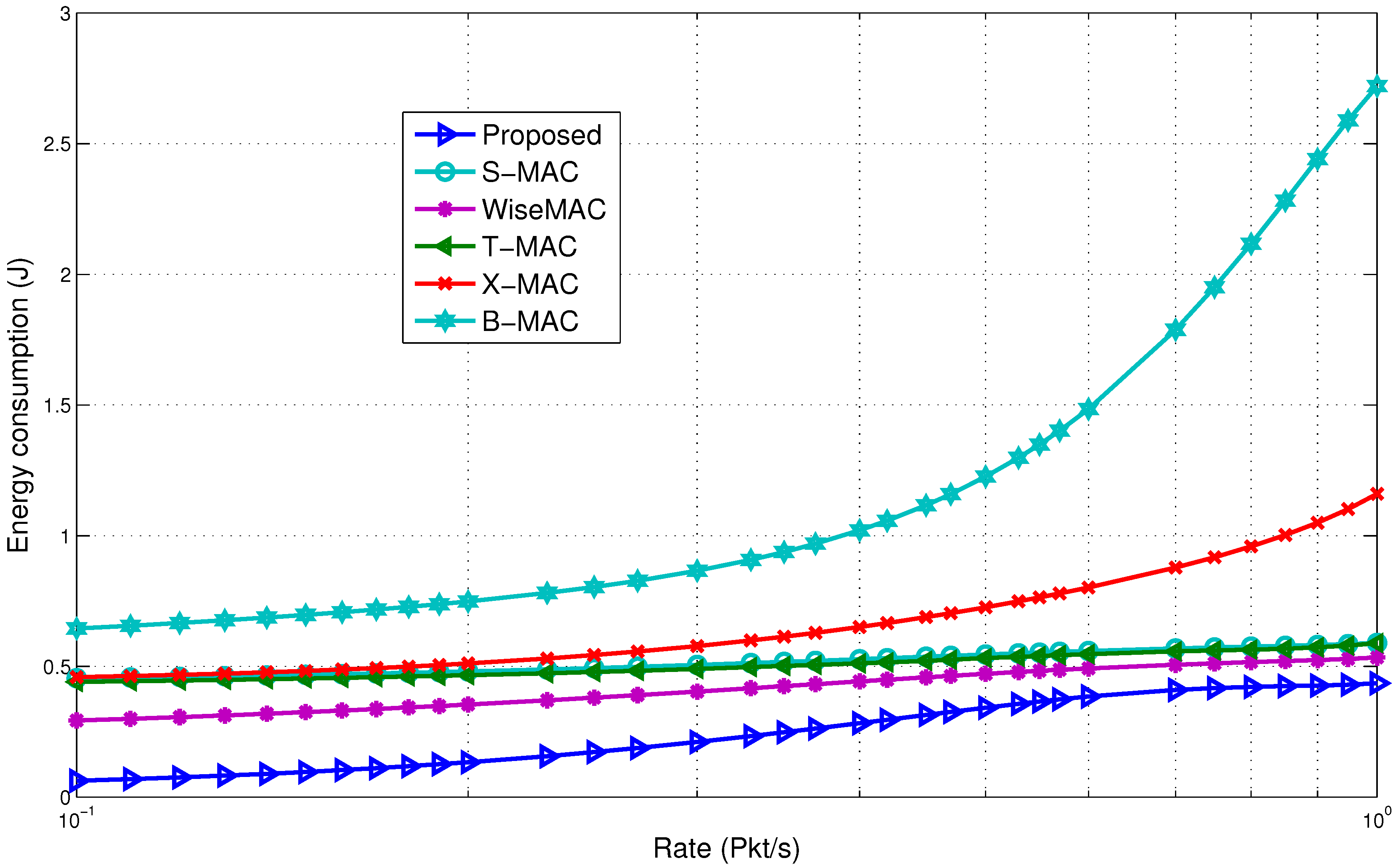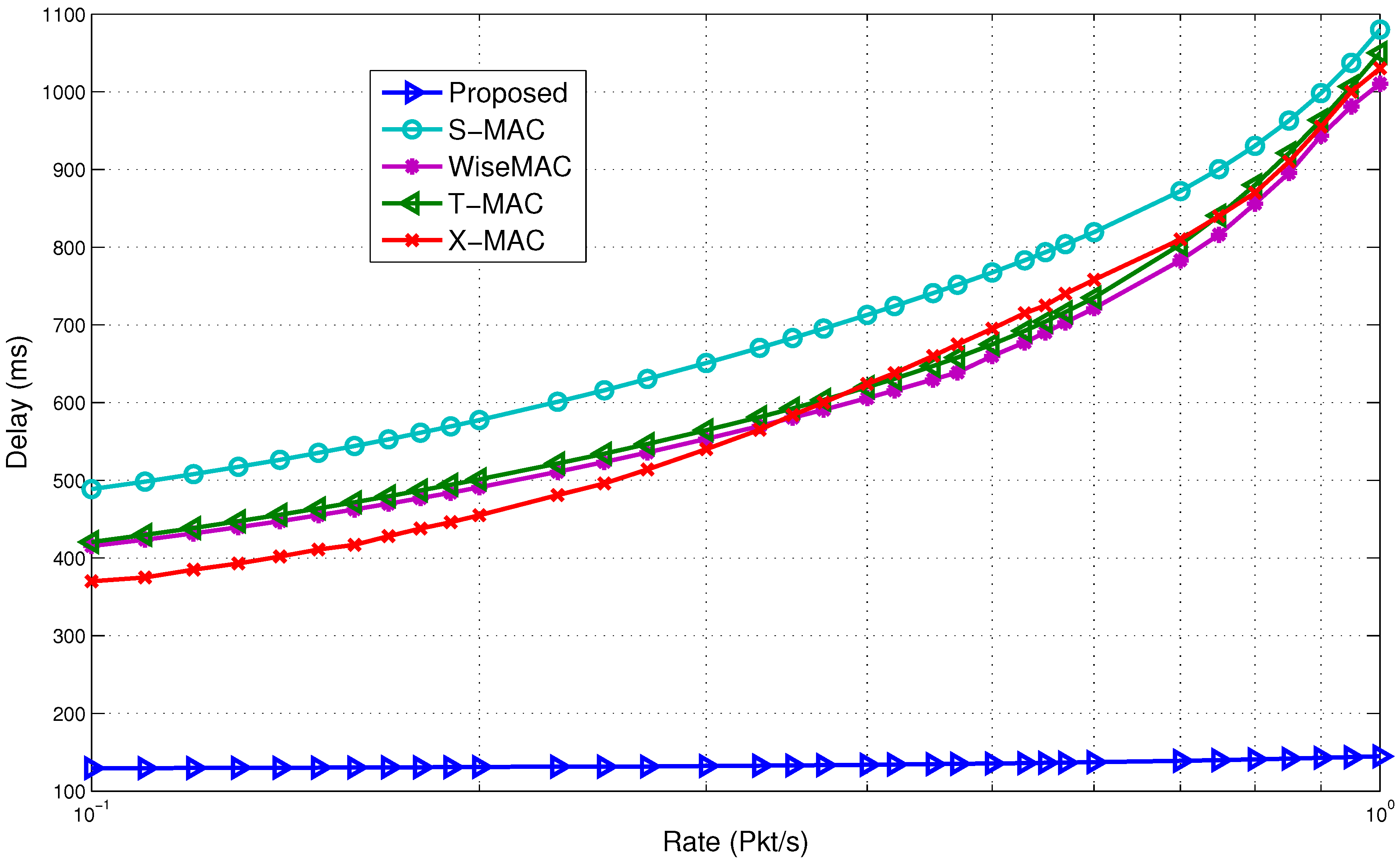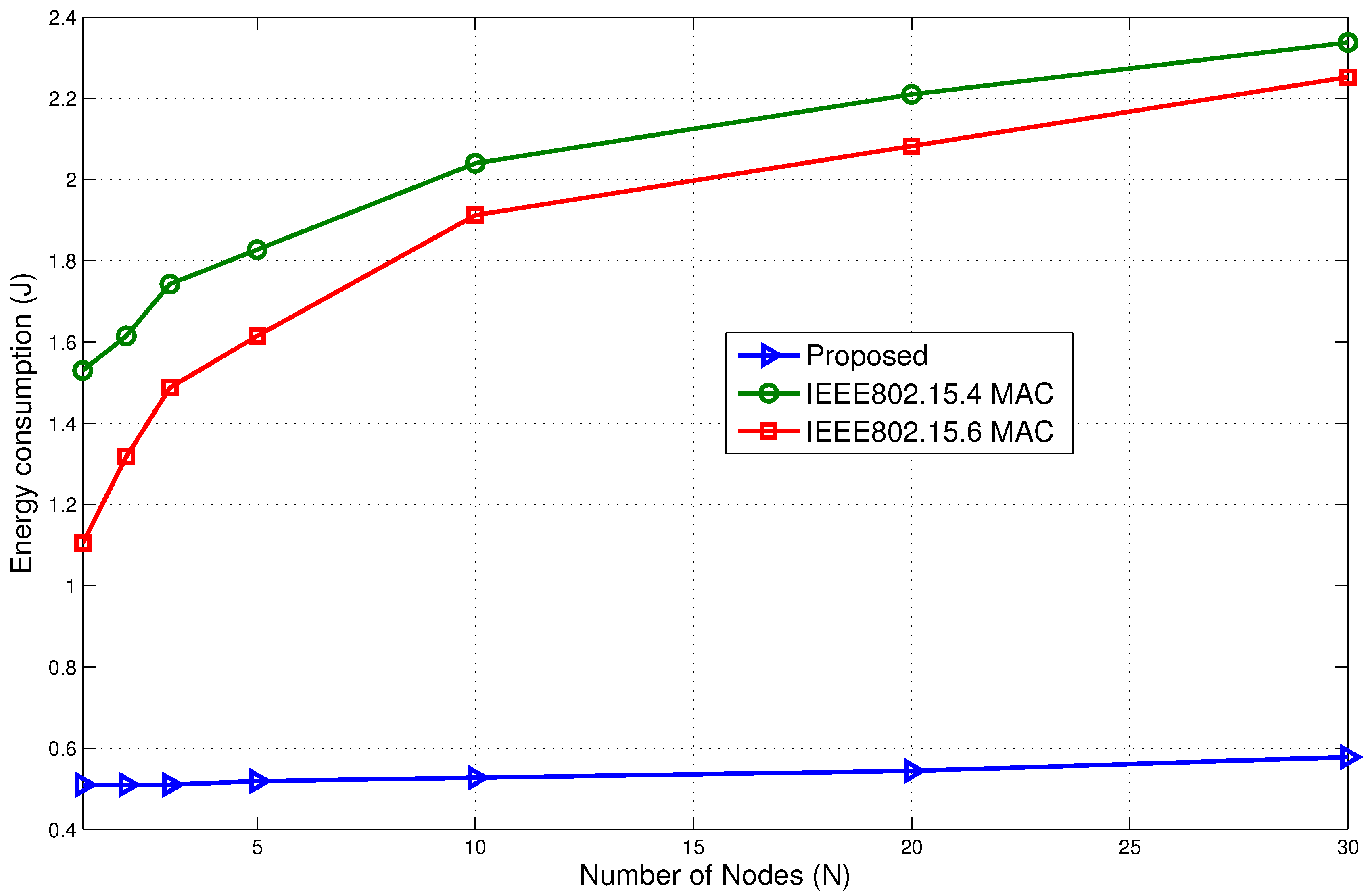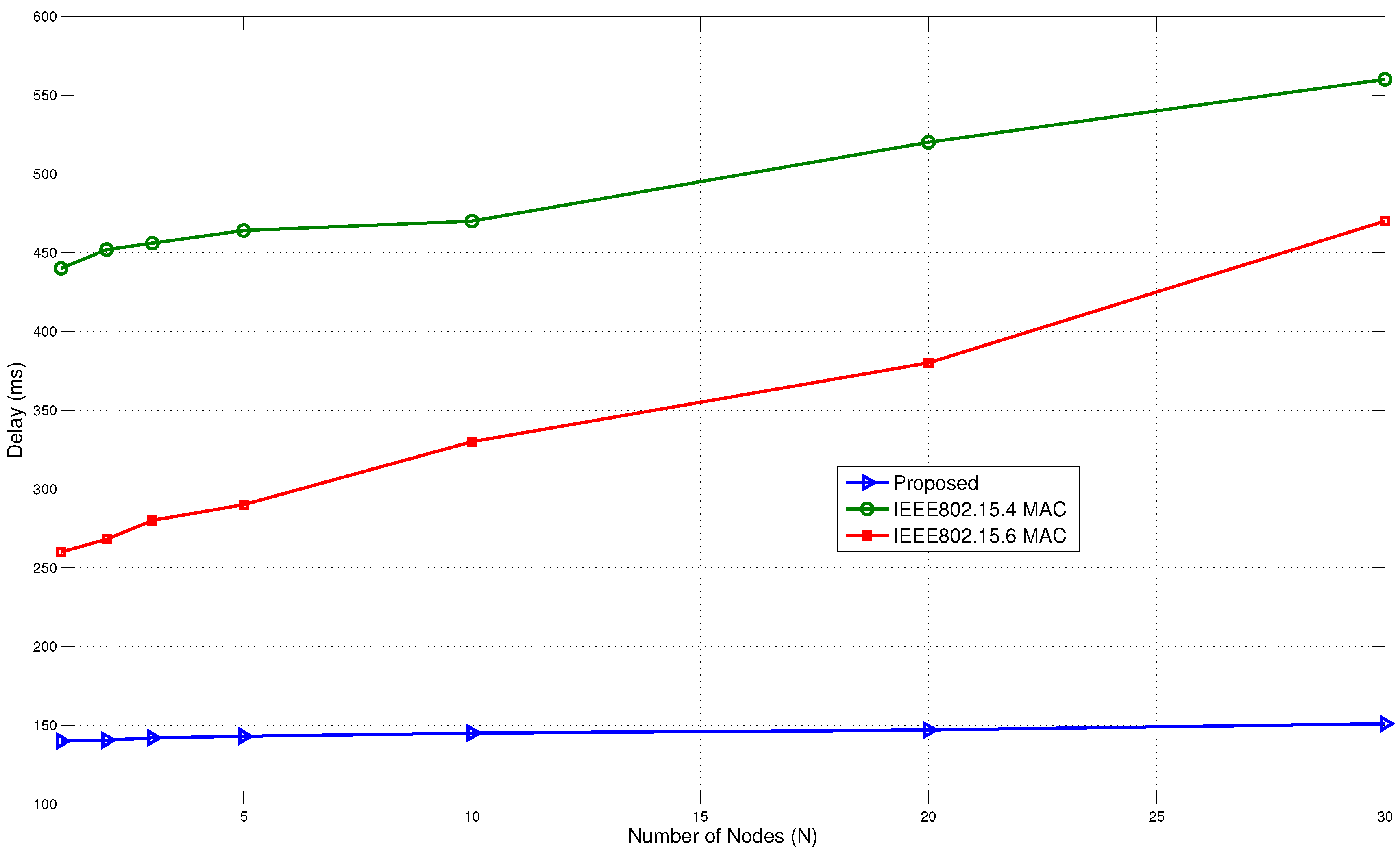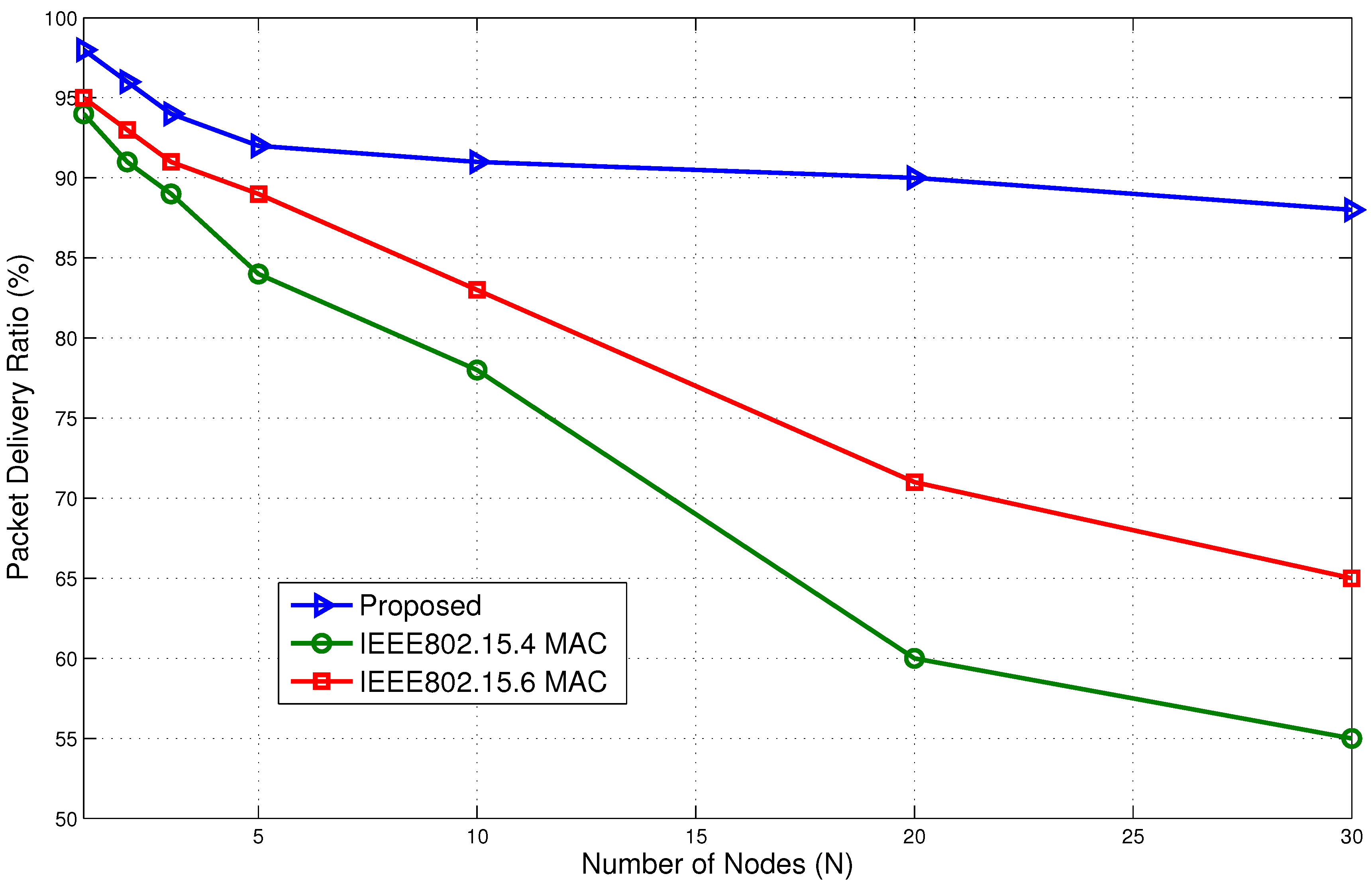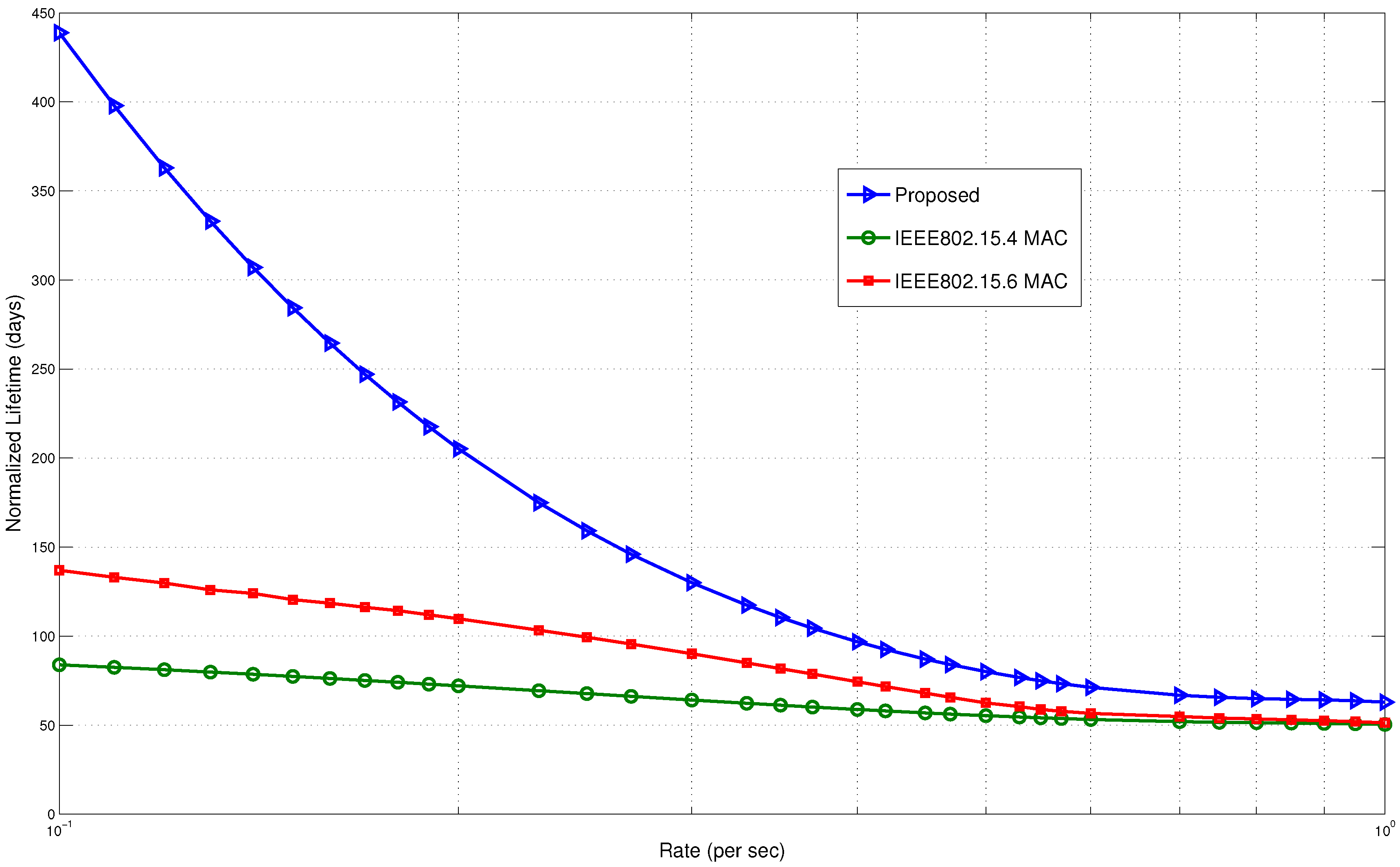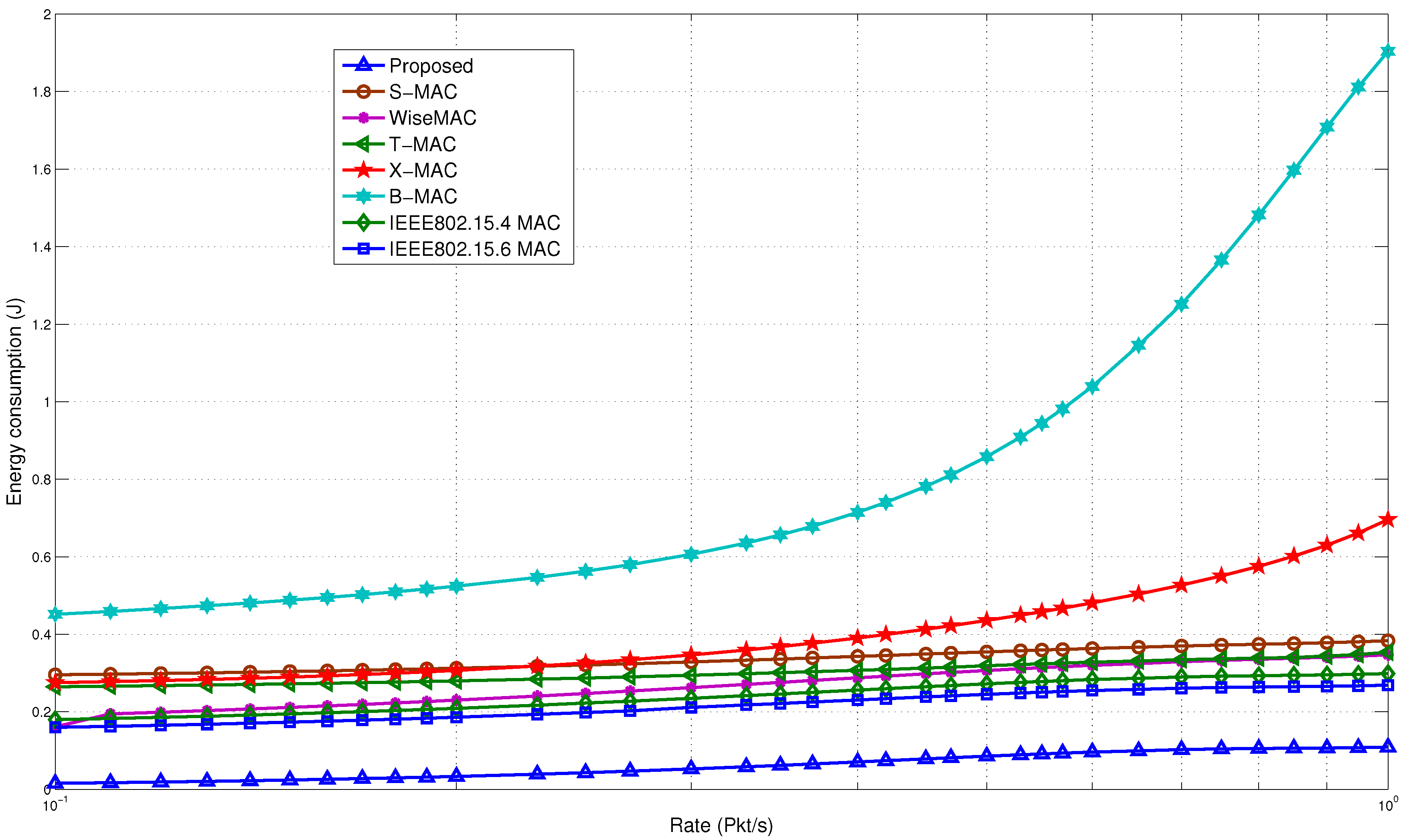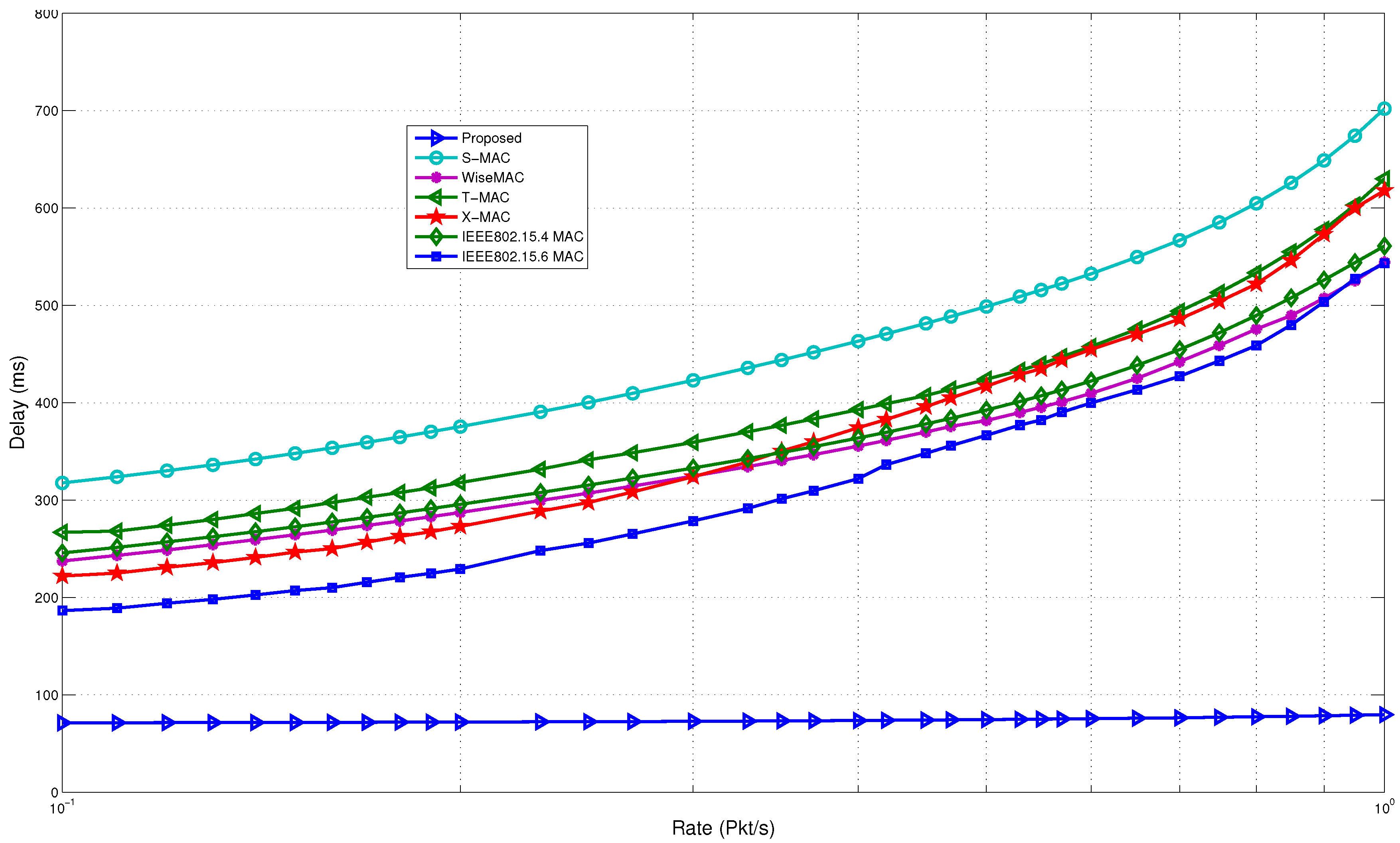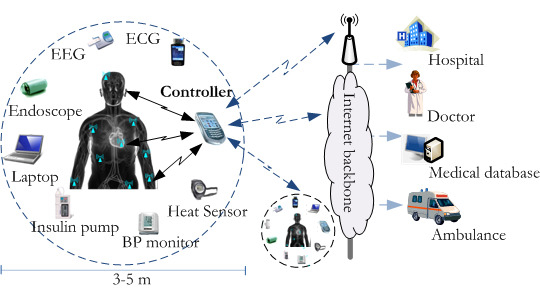1. Introduction
Recent advances in wireless, pervasive and ubiquitous information and communication technologies (ICT) have enabled sensor devices to safely operate on and around the human body. These devices monitor the body functions and the surrounding environment. A network of such devices is known as a body area network (BAN) [
1,
2]. A BAN has great potential to improve the quality of a personal healthcare system. It can provide cost-effective, portable and reliable healthcare services. The seamless integration of different systems and applications provides improved quality of life [
3]. A BAN system aims to deliver healthcare not only to patients in hospitals, but also in workplaces and private areas, such as homes and remote locations. The applications of a BAN [
4] cover both medical and non-medical fields.
A typical BAN structure is shown in
Figure 1. It consists of devices (also called BAN nodes or BN) and a BAN network coordinator (BNC). The communication in a BAN can be of two types: intra-BAN and outer-BAN. In this work, we focus on intra-BAN communication. A BAN can have normal (scheduled) or emergency traffic (random). BAN devices are usually resource constrained in terms of processing capability and battery and memory capacity. Low energy consumption, delay, lifetime and security are among the key design factors of a BAN.
Figure 1.
A typical architecture of a BAN.
Figure 1.
A typical architecture of a BAN.
Energy is consumed for sensing and processing the data and communication. Communication consumes the greatest amount of energy. Efficient energy management is a key requirement in a BAN. A popular method to conserve energy is to switch off (sleep) the transceivers of a node. However, to communicate, the transceivers must be switched on (wake up). This sleep and wake up mechanism is an integral part of energy-efficient operation in a sensor network. Various wake up mechanisms [
5] have been proposed to increase the performance of the network. The major approaches are
- -
Internal self-triggered wake up;
- -
External out-of-band radio-triggered wake up.
The internal self-triggered wake up is performed by the device itself. In a normal scenario, it uses a timer to trigger the wake up. It is the most widely-used method. It can be scheduled or unscheduled. The external out-of-band radio-triggered wake up is performed by sending an interrupt signal through the pins of the MCU.
In existing systems, if the sleeping node is the intended receiver, the sender must defer transmitting until it is awake. The majority of the state-of-the-art MAC protocols, such as Sensor MAC (S-MAC) [
6], Time-out MAC (T–MAC) [
7], Berkeley MAC (B-MAC) [
8], WiseMAC [
9] and X-MAC [
10], employ this procedure. These protocols lack a suitable mechanism to immediately communicate if the node is in the sleeping state. This hampers immediate emergency traffic communication. Use of an “always on” sink device is not feasible. There is a high probability that the downlink communication may suffer from a longer delay in an unscheduled environment. This has been observed in the existing IEEE802.15.x standard MAC protocols, as well. To overcome these problems, the existing protocols employ wake up schedules. Adaptive scheduling is employed in several of the MAC protocols. However, emergency traffic is random and unpredictable in nature. The delay is a major concern in the case of an emergency and may result in unwanted consequences if not handled promptly. Our aim is to solve this problem by using an external wake up mechanism. An out-of-band wake up mechanism can be used to avoid the idle waiting time of the nodes. The authors in [
11,
12] have proposed an out-of-band wake up radio system for sensor networks. The wake up radio mechanism works on the basic idea that a node can be woken up by an external trigger. It can be effectively used in an unscheduled environment.
In this paper, we propose a mechanism for emergency communication using a wake up radio. A node, when sensing an emergency event, can use the wake up radio to wake up the receiver node. Our aim is to prompt communication between nodes. Reducing the energy consumption and thereby increasing the lifetime are major design goals. The rest of the paper is organized as follows. In
Section 2, we present related works and the motivation behind this work. In
Section 3, we present the system design and modeling. In
Section 4, we present the performance analysis. In
Section 5, we present the performance evaluation. In
Section 6, we present the sensitivity analysis. Finally, conclusions are drawn in
Section 7.
2. Related Works and Motivation
The major applications of a BAN are in the healthcare domain. This is a very sensitive area. Therefore, the MAC protocols proposed for a BAN require extra care. The design of a MAC protocol for a BAN is influenced by several attributes [
13]. Energy-efficient design incorporating low delay has been proposed by several authors in recent times. Some of these works focus on designing a comprehensive MAC protocol, while others focus on a particular application area (e.g., emergency handling). A wider range of MAC protocols is proposed. It has been observed that the time division multiple access (TDMA) and carrier sense multiple access (CSMA) mechanisms are the most popular in MAC protocols for a BAN. TDMA is preferred in earlier times, as it offers better performance in unsaturated traffic condition. The authors in [
14] have proposed a TDMA-based MAC protocol design for a BAN. They have used the MAC frame structure with the uplink and downlink subframe using an adapting scheme. A simulation study with 24 nodes is presented. Their method tries to improve energy consumption using a pure TDMA scheme and does not use a contention-based mechanism. In the unscheduled wake up scheme, all of the nodes in the network have an independent wake up schedule. Since they do not know the wake up schedule of other devices, carrier sensing (CS) is employed to avoid collisions. WiseMAC, proposed in [
9], is an example of such a MAC protocol. The collision-free time slot allocation method is proposed in [
15]. The authors have proposed a distributed queuing body area network (DQBAN) MAC protocol using the process of the demand and deny time slot allocation scheme. They have used a cross-layer fuzzy-rule scheduling algorithm, which makes a node send a packet in the next frame instead of the first frame, thereby achieving better reliability. The evaluation shows a better packet success rate. MAC protocols using a hybrid wake up mechanism try to take advantage of both scheduled and unscheduled wake ups. An example of a hybrid wake up MAC is the IEEE802.15.4 MAC [
16]. It supports the beacon-enabled and non-beacon-enabled modes of operation and uses contention and contention-free access mechanisms. Among the recent works on hybrid MAC, the authors in [
17] proposed a cross-layer data dissemination approach for a BAN. It uses an adaptive priority scheme to reduce idle listening by the nodes and ensures effective traffic differentiation. The implementation shows lower energy consumption.
Emergency events are an integral part of a BAN. The authors in [
18] have proposed a mechanism for emergency data transfer in a medical implant communication service (MICS)-based body area network. The authors in [
19] have proposed an algorithm for priority-based allocation of time-slots (PATS) that considers a fitness parameter characterizing the criticality of health data that a packet carries, as well as the energy consumption rate for transmitting local data processing units. The authors in [
20] have proposed the medical emergency body (MEB) MAC protocol that dynamically inserts listening windows and utilizes idle time slots to insert additional listening window opportunities for emergency traffic. The authors in [
21] proposed a MAC protocol using an interrupt mechanism for medical monitoring applications. It is a hybrid MAC protocol and uses scheduled and contention access for data communication.
As mentioned earlier, the popular MAC protocols proposed for sensor networks can also be used in a BAN with trade-offs between energy consumption, lifetime and delay. Some of these protocols are S-MAC, T-MAC, Wise-MAC, B-MAC and X-MAC. For example, S-MAC, which uses a periodic sleep/wake up mechanism to conserve energy, can be used in a synchronized BAN. T-MAC has adaptive active time and can be used under variable traffic conditions. B-MAC uses a long preamble for communication. It can be used in a low traffic environment, as it has low energy consumption for low traffic and no synchronization overhead. The preamble sampling of WiseMAC is a strong candidate for BAN-related applications. It has low energy consumption and can adapt under variable traffic conditions. X-MAC, unlike B-MAC, uses small strobe preambles. It can be used for low delay applications. It also does not require synchronization, thereby reducing overheads. The IEEE 802.15.4 standard is devised to support low data rate, low power networks. The physical layer has 27 communication channels for industrial, scientific and medical (ISM) bands. The IEEE802.15.4 MAC has been proposed for a BAN [
22]. It adopts carrier sense multiple access with collision avoidance (CSMA/CA) as the channel access mechanism. It supports a star topology and can be implemented in a typical BAN. The IEEE802.15.6 MAC [
23] is a new standard protocol proposed for a BAN. It addresses both medical/healthcare and non-medical applications with diverse requirements. The MAC layer in the standard defines a short-range, wireless communication in and around the human body.
However, these protocols have several drawbacks. For example, the S-MAC protocol has a fixed periodic sleep and wake up mechanism. To reduce collisions among contending nodes, it uses the request to send (RTS) and clear to send (CTS) control packet’s handshake mechanism. However, this increases the overhead energy consumption. It also spends much time in idle listening, which causes energy waste. T-MAC improves the performance of S-MAC. However, it has an early sleeping problem. The receiver node waits for a fixed period of time, and after that, it goes to the sleep state if no activity is detected. At the same time, the idle listening period introduces overhead energy consumption. WiseMAC uses preamble sampling. It has low energy consumption and better performance under variable traffic conditions. The clock drift handling mitigates the external time synchronization requirement. The neighbor nodes may have different sleep and wake up times, which result in redundant transmission in the case of packet broadcast. This leads to higher energy consumption and latency. The probability of collision is high at the beginning of transmission of the preamble. The long preamble of B-MAC causes a longer delay. X-MAC is able to reduce the cost of a long preamble by using short strobe preambles. On average, it uses two preambles for one successful data transmission, which causes extra energy consumption. The approach used in these protocols is also known as the internal wake up mechanism due to the fact that these protocols use an internal clock to self-trigger a wake up. Another method is called external wake up, also known as the out-of-band wake up. In the next section, we present a detailed discussion of the external wake up mechanism.
2.1. Wake up Radio
An early work on an external radio-triggered wake up mechanism was proposed by the authors in [
5] for sensor networks. They used a secondary transceiver called a wake up transceiver in each device in the network. It is controlled by a wake up circuit. A wake up receiver can respond immediately to the requests from other nodes, and the latency can be reduced.
The power consumption of the recently-developed wake up circuits is very small. These are in the range of a few μW compared to a few mW for the main radios used for data communication. The power consumption of some of the wake up radios is presented in
Table 1.
For example, a basic wake up receiver presented in [
11] needs only 84 μW for reception, whereas the CC1100 radio receiver consumes 29 mW. In other words, the wake up radio consumes only 0.03% of power compared to the CC1100 radio receiver. This in the long term contributes significantly to the conservation of power.
The goal of the wake up radio is to send a remote interrupt signal to a device. The basic working of a wake up radio includes sending an RF signal to a device in order to wake it up. The wake up radio system is powered by the energy received from the wake up radio signal. This energy is used to power up the components. After receiving the wake up signal, the target device powers on its main radio, as shown in
Figure 2. An active wake up radio system can be used to send an acknowledgment back, confirming the reception of the wake up packet.
Table 1.
Wake up radio and power consumption.
Table 1.
Wake up radio and power consumption.
| Wakeup Radio Model | Wakeup Power |
|---|
| Basic receiver [11] | 84 μW |
| WuP [24] | 470 nW |
| CargoNet [25] | 4.8 μW |
| Ultra-Low Wakeup [26] | 7.5 μW |
| Wakeup receiver [27] | 171 μW |
| RTWAC [28] | 2.6 μW |
| Picoradio [29] | 1 μW |
Figure 2.
Wake up radio communication.
Figure 2.
Wake up radio communication.
A wake up radio system saves energy by eliminating the causes of energy waste, such as idle listening, control packet overheads, overhearing and over-emitting. An external wake up radio system does not use specified wake up periods to listen to the channel for possible messages. In traditional MAC systems, a node has to turn on its main transceiver to listen to a channel. This uses much energy. However, a wake up radio system does not need idle listening and wake up periods. A wake up radio only responds to the low power incoming signals. It can keep its main radio in the off state and save energy. As explained in the next section, using addressing, it can also reduce the waking up of neighboring nodes.
The majority of the MAC protocols use control packets to establish the connection in the form of a handshake (request and permission for packet transmission) between two nodes. Beacon and poll packets are used for resource allocation. These packets are transmitted using the main radio. A wake up radio also uses handshake packets. However, the difference in energy consumption by the main radio and a wake up radio is large enough to affect the performance. Thus, the power that was previously dedicated to transmitting other control packets on the transmitter side and periodic monitoring on the receiver side can be replaced by the power consumption of the wake up radio system.
Another major problem is overhearing. The use of the main radio to overhear a possible packet transmission is very costly in terms of energy consumption. The popular CC2420 radio uses 35 mW for transmission and 38 mW for the reception. The CC1000 radio uses 42 mW for transmission and 29 mW for the reception. A wake up radio can complete the same task at a fraction of the energy required by the main radio, as is evident from
Table 1. The energy use is in μW for the wake up radio and several mW in the case of the main radio. An external wake up radio helps to restrict the use of the main radio for data packet transmission only, thereby saving a significant amount of energy.
The use of a wake up radio-based system can benefit a BAN, as it can save a significant amount of energy. This can in turn help increase the network lifetime. In our work, we propose to use an ultra low power wake up signal to trigger the wake up circuit inbuilt in a BAN node.
2.1.1. Wake up Radio Packet and Addressing
Addressing is an important factor in the wake up radio. It is used for selective communication. A flow chart of a typical wake up radio-based system using addressing is shown in
Figure 3. It is to be noted that energy is consumed to decode a wake up packet to determine the recipient. However, unlike the originally-proposed wake up radio models [
5,
11], addressing can reduce the waking up of all of the nodes in the neighborhood with a slight increase in the complexity [
30].
Figure 3.
Flow of the wake up radio system with addressing.
Figure 3.
Flow of the wake up radio system with addressing.
2.1.2. Implementation of the Wake up Radio
A wake up radio can be implemented using simple hardware, as shown in
Figure 4. A working implementation of a wireless sensor node with a wake up radio is presented in [
27]. It consists of a wake up radio circuit attached to the T-node platform. It consists of an 8-MHz ATmega128L (Atmel Corporation, San Jose, CA, USA)) processor and Chipcon CC1000 radio, which operates in the European license-free 868-MHz band. It uses on-off keying (OOK) modulation with a symbol rate of 862 Hz.
Figure 4.
Example of the wake up radio architecture.
Figure 4.
Example of the wake up radio architecture.
The high-level design of the wake up circuitry and its interface to the T-node components is shown in
Figure 5 [
27]. At first, the incoming signals from the antenna are fed through a frequency filter to suppress external interference (mainly GSM signals at the 900-MHz band). Then, the 868-MHz signal is converted down to a low-frequency baseband signal using a simple diode. It is followed by a large amplification to make the signal detectable by an ultra-low-power microcontroller. This microcontroller applies some digital processing to filter the residual (self) interference still present in the input signal. Once the wake up signal is detected, the ATmega128L processor of the T-node is triggered into action by means of an interrupt, which will in turn switch on the CC1000 radio to receive the data packets [
27].
Figure 5.
A wake up radio attached to the T-node.
Figure 5.
A wake up radio attached to the T-node.
A wake up signal is transmitted at 3 mW from 10 m away and attenuated to a level of −51 dBm, which is equivalent to 10 μV peak-to-peak on the antenna line. After an attenuation of 3.5 dB caused by the frequency filter, this reduces to a mere 5 μV. It is used with a CC2530 chip using the 2.4-GHz transceiver. In another work, the authors in [
31] have implemented a system for sensor networks using a low complexity wake up radio, as shown in
Figure 6. The clock rate of the programmable intelligent computer (PIC) can be either increased to the next level at 125 kHz, or the frequency of the wake up signal can be lowered. It is to be noted that the PIC also contains an internal comparator, but operating it consumes at least 90 μW due to the need to keep it on continuously because of its longer setup times.
PicoRadio [
29] is one of the earliest works on wake up radio monitoring in the environment. It uses a very low power transceiver module. RTWAC [
28] is a radio triggered wake up with addressing capability that allows suppressing current consumption during the idle state. It consists of an external low-cost hardware wake up circuit attached to the microcontroller of the sensor device. In [
29], the authors have proposed a radio-triggered wake up circuit to control the operation of sensor devices. The authors in [
32] have proposed a dual-radio cooperation that uses a low-power wake up radio to minimize the energy consumption of the wireless node in low event rates. All of these works show that the wake up radio is a promising technology. It can be effectively used for short-range communication.
Figure 6.
A low-complexity wake up receiver (WuRx) attached to a wireless sensor node.
Figure 6.
A low-complexity wake up receiver (WuRx) attached to a wireless sensor node.
2.2. Motivation behind Using the Wake up Radio for BAN
A BAN can use the wake up radio to reduce the energy consumption and prolong the lifetime of the nodes. It can be used for both emergency and regular (normal) communication. For regular communication, a major motivation is that a node should wake up only when there is a need for communication, or else, it should remain in the sleep state and conserve energy. A wake up radio transceiver added to each node can help to meet this goal. Unnecessary wake up periods for a node can be avoided, which can minimize energy consumption. This in turn increases the lifetime of the nodes. There is a lack of a satisfactory means to communicate immediately in current protocols, and delay is a major issue. This is also true in the case of the IEEE15.x standard protocols.
2.2.1. Sensitivity of the Wake up Radio
The sensitivity of a wake up radio receiver can be derived using the Friis free space equation.
where
L is the wavelength of the signal,
d is the distance,
n is the empirical path loss exponent,
is the transmitted power,
is the antenna gain for the transmitter and
is the antenna gain for the receiver. We can find a reasonable range for the wake up receiver with acceptable sensitivity. As mentioned earlier, in an application like a BAN, a short range of 3–5 m is adequate. The traditional 2.4-GHz ISM band can be used for the wake up signal.
If we assume
=
= 1.5 dBi and a radiated power Pt = 0 dBm, we can find the received power (in dBm). It is given by,
It can be seen from
Table 2 that we can use a wake up radio with sensitivity −58 dBm in a BAN for a range up to 5 m. The sensitivity can be increased with higher antenna gains. The power usage limits the range of a typical wake up radio. However, this makes itself suitable for short-range applications, such as a BAN.
Table 2.
Sensitivity of the wake up radio.
Table 2.
Sensitivity of the wake up radio.
| Distance (m) | n | Pr (dBm) |
|---|
| 3 | 2 | −46.61 |
| 3 | −51.38 |
| 5 | 2 | −51.05 |
| 3 | −58.04 |
A wake up radio-based system through an on-demand request can significantly reduce the idle state energy consumption. A typical BAN has a 3–5 m coverage area. As seen in
Figure 7, a BAN can take advantage of the high wake up probability at short range [
33]. In addition, there is only a very limited impact on latency because the corresponding node wakes up immediately. In recent times, wake up radios intended for a BAN have been researched. Several works are underway to further improve the receive power. The authors in [
24] developed a nano-power wake up radio for a BAN.
The wake up radio-based MAC that we propose here takes advantage of a typical BAN network as follows:
- -
a smaller network size in terms of nodes compared to typical WSN;
- -
limited communication range;
- -
a BAN node can be easily triggered by an external wake up radio signal;
- -
the wake up radio requires little extra cost in terms of power consumption.
Figure 7.
Wake up probability vs. distance.
Figure 7.
Wake up probability vs. distance.
4. Performance Analysis
A slotted contention-based mechanism is used for communication. An example MAC operation is shown in
Figure 13. A BN with an emergency event uses channel sensing to check the channel for activity. It also uses the back-off mechanism to avoid collisions. In the next section, we discuss the back-off mechanism.
Figure 13.
Example MAC operation using the wake up radio.
Figure 13.
Example MAC operation using the wake up radio.
4.1. Back-Off Mechanism
Before attempting to transmit, a BN utilizes the back-off mechanism. It chooses the value from the range [0, B], where the back-off window size (B) can be fixed or adapted as per the requirements. The value a BN chooses is called the back-off counter. It is expressed in terms of slots. The counter value is decremented one slot at a time. For example, if a BN chooses a back-off value of three, it waits for three slots before reattempting to transmit the packet. Once the counter expires, the BN senses the channel. If the channel is idle, it transmits the wake up radio packet. If it senses the is channel busy, it chooses a new value for the counter, and the process is repeated. It is to be noted that a number of back-off algorithms can be used depending on their feasibility in a particular BAN application. The flow chart of the back-off mechanism is shown in
Figure 14.
Figure 14.
Back-off mechanism.
Figure 14.
Back-off mechanism.
The average back-off size (
) is given by,
In this work, we have assumed a Poisson distribution for traffic. For a network with N nodes, the total rate is given by
. For analysis, we consider the two periods, idle and active. The idle period is the time when a BN does not transmit or receive. In the idle period, a BN can shut down the transceivers and go to the sleep state. Thus, a BN is said to be idle from the end of the last packet transmission until the start of the next transmission. Similarly, a BN is active from the moment a transmission starts until the end of the transmission. The notations used in this work are presented in
Table 3.
Table 3.
Description of notations.
Table 3.
Description of notations.
| Notation | Description | Units |
|---|
| N | Number of nodes | - |
| Slot duration | ms |
| Duration between packet arrivals | ms |
| Idle period | ms |
| Active period | ms |
| Wake up radio duration | ms |
| Wake up packet transmission time | ms |
| Wake up acknowledgment time | ms |
| λ | Arrival rate | packet/s |
| α | Attempt rate | packet/s |
| A | Random time between the first and last packets | ms |
| Busy channel probability | - |
| Mean busy period to transmit the wake up packet | ms |
| Mean busy period to receive the wake up ACK | ms |
| Time a BN spends in transmitting | ms |
| Time a BN spends in receiving | ms |
| Time a BN spends in idle state | ms |
| E | Energy consumption by a BN | mW |
| Overhead energy consumption | mW |
| Waiting time when channel is initially idle | ms |
| Average time for the initial successful attempt | ms |
| B | Back-off window size | slots |
| D | Delay | ms |
| Probability of successfully transmitting the packet | - |
| Lifetime | days |
| CCA | Clear channel assessment | ms |
| Transmitting power | mW |
| Receiving power | mW |
| Length of wake up acknowledgment packet | bytes |
| Transceiver switching time | ms |
| Transceiver switching power | mW |
| Transition time | ms |
| Transition power | mW |
| Time required for CCA | ms |
| Power required for CCA | mW |
| r | Data rate | kbps |
4.2. Energy Consumption
The cumulative distribution of the duration from the end of the last packet transmission until the start of the arrival of the next packet (
) is given by,
This is equal to the mean duration of the idle period.
The active period is given by,
where
is the summation of the time required to send and receive the wake up radio packets and is given by,
The parameter A is a random variable with a cumulative distribution as follows,
The probability distribution function is given by,
In this case, the mean is given by,
Therefore, the mean active period is given by,
We calculate the energy consumption considering the successful transmission during an event. The SWUF is used to inform the receiver about the emergency event. Let be the busy channel probability during the active period. The corresponding idle channel probability is given by (). During an active period, we assumed that the transmission follows the Poisson process. In this case, the rate is given by .
In an active period at the BN, it spends some time in the idle period. The cumulative distribution of this duration is given by,
The mean in this is given by,
The mean busy period for transmitting the wake up packet is given by,
The mean busy period for receiving the wake up acknowledgment packet is given by,
Now, we find the transmitting and receiving time for the BN. The proportion of time a BN spends in the transmitting state is given by,
The proportion of time a BN spends in the receiving state is given by,
We can find the expression for
and
as follows,
The proportion of time a BN spends in the idle state is given by,
The energy consumption (
E) by the BN is calculated by adding the energy consumption in all of the states, transmitting, receiving and idle, including the overheads, and is given by,
where
is the overhead energy consumption. It is given by,
4.3. Delay
The delay is calculated starting from the time of channel sensing till the acknowledgment is received. As mentioned earlier, when the BN detects an event, it senses the channel. If it initially finds the channel idle, it transmits the packet. However, in the case of the busy channel, it invokes the back-off process and waits till the back-off counter expires.
If the BN initially finds the channel idle, it transmits the packet. In this case, the average waiting time is given by,
The parameter
is given by,
Then, the average waiting time is given by,
The average time for the initial successful attempt is given by,
Now, we take into account the fact that a BN retransmits the wake up radio packet once the WACK time expires, i.e., it does not receive the WACK from the receiver. During retransmission, the BN again invokes the back-off procedure.
The delay (
D) until the wake up packet is successfully transmitted is given by,
The probability of successfully transmitting the wake up packet
is given by,
4.4. Lifetime
The lifetime
(in number of days) is calculated using the following expression,
4.5. Analysis for Other Systems
We have compared our model against some of the well-known state-of-the-art MAC protocols. In this section, the expressions for energy consumption and delay are presented.
Let
,
,
,
,
,
and
be the average energy consumption of the WiseMAC, X-MAC, B-MAC, T-MAC, S-MAC, IEEE802.15.4 and IEEE802.15.6 MAC protocols, respectively. The expressions for the average energy consumption are as follows:
where:
Let
,
,
,
,
,
and
be the delay of the WiseMAC, X-MAC, B-MAC, T-MAC, S-MAC, IEEE802.15.4 and IEEE802.15.6 MAC protocols, respectively. The expressions for the delay are as follows:
6. Sensitivity Analysis
In this section, we present a discussion of the impact of factors, such as overheads and packet size, on the existing and proposed schemes. We also present a component-wise analysis for energy consumption and the wake up time and overhead times of the discussed systems.
6.1. Impact of Overhead on Energy Consumption
The overheads affect the performance of a MAC protocol. It is a major design factor. MAC protocols, such as B-MAC and X-MAC, have reduced performance due to the energy consumed by overheads. Therefore, reducing the overheads is one of our major design goals. Our aim was to reduce overheads as much as possible. The impact of overhead on energy consumption is shown in
Figure 29. B-MAC has the largest overheads due to the long preamble, which significantly increases the energy consumption as the traffic rate becomes higher. X-MAC improves on the results of B-MAC through the use of small strobe preambles. T-MAC, S-MAC and WiseMAC have a lower proportion of overheads than B-MAC and X-MAC. However, they are still a bigger part in the total energy consumption. The RTS-CTS packet handshaking is a major cause of energy consumption. Since these protocols use the main radio to send the control packets, the energy consumption is very high. The transmission and reception power of 26 mW and 13.5 mW affects every control packet. As the number of nodes increases with a higher arrival rate, the energy consumption also increases. The same handshake is performed using the wake up radio in the proposed model, which uses very low power for operation (in μW). The standard IEEE802.15.4 MAC has to contend with two clear channel assessments (CCA) before attempting any transmission. The IEEE802.15.6 MAC protocol suffers from typical CSMA/CA-based overheads along with beacon packets. The overhead energy consumption is still higher than the proposed model.
Figure 29.
Impact of overhead on energy consumption.
Figure 29.
Impact of overhead on energy consumption.
As mentioned earlier, it is a common practice to turn off the main radio to save energy. However, it is very difficult to manage the wake up schedule in an energy-efficient way. A wake up radio system can easily avoid the periodic wake ups of the schedule-based MAC protocols. The nodes in these protocols have to wake up even though there are no packets to receive. Similarly, a wake up radio system can avoid the periodic channel assessment. It can also avoid idle listening, which is done in anticipation of new packets. The use of a wake up radio also reduces energy consumption due to control packets in the network.
6.2. Impact of Overhead on Delay
The overheads also affect the delay. The most affected is the S-MAC protocol. It has a large number of control packet overheads in the network. The synchronization packet and the RTS-CTS packets cause higher delay. It also has to deal with fixed wake up periods, which causes a longer waiting time for the sender. The impact of overhead on delay is shown in
Figure 30. WiseMAC has to deal with a long preamble. X-MAC incurs overheads from multiple strobe preambles. The IEEE802.15.x MAC protocols have channel assessment and control packet delay overheads. The proposed MAC gets overheads from the wake up radio. However, on-demand and efficient scheduling has reduced overall overheads in the network. On average, it is able to decrease overhead delay by 2–3 times compared to the rest of the protocols. The wake up radio also reduces energy consumption by reducing the waiting time. It maintains prompt and immediate communication for emergency packets.
6.3. Impact of Packet Size
The impact of the data packet size is homogeneous for all the MAC protocols, as is evident from the energy consumption and delay expressions. However, changing the size of the control packets used in scheduled and unscheduled MAC protocols can individually affect their performance. For example, reducing the preamble size in B-MAC can reduce the delay, while increasing the miss probability. The smaller preamble in X-MAC can lower delay, as well. The increase in the length of the control packets in WiseMAC does not affect its performance. This is also true for the IEEE802.15.x MAC protocols.
Figure 30.
Impact of overhead on delay.
Figure 30.
Impact of overhead on delay.
6.4. Component-Wise Analysis
The component-wise energy consumption is presented in
Table 6. The main components are wake up, transmit, receive and overheads. The parameters used are presented in
Table 4 and
Table 5. All units are in Jules. We can clearly see that the proposed system is ahead in terms of energy conservation. The data and acknowledgment (ACK) packets are transmitted using the main radio in the case of all of the systems. However, the wake up process is handled by the wake up radio for the proposed system, preamble sampling for WiseMAC, beacon for the IEEE802.15.4x protocols, RTS/CTS for the S-MAC and T-MAC protocols, long preamble for B-MAC and short strobe preambles for the X-MAC protocol. The proposed protocol is able to reduce the overheads significantly. It contributed to the overall reduction in the energy consumption for the proposed scheme.
Table 6.
Component-wise break down of energy consumption (units are in Joules).
Table 6.
Component-wise break down of energy consumption (units are in Joules).
| Components | Proposed | WiseMAC | X-MAC | B-MAC | T-MAC | S-MAC | IEEE802.15.4 | IEEE802.15.6 |
|---|
| Wake up/Preamble | 0.0046 | 0.246 | 0.211 | 0.213 | 0.472 | 0.55 | 0.968 | 0.557 |
| Transmit data | 0.3936 | 0.3936 | 0.492 | 0.984 | 0.394 | 0.472 | 1.26 | 1.26 |
| Receive ACK | 0.0768 | 0.0768 | 0.0768 | 0.0768 | 0.0768 | 0.0768 | 0.0768 | 0.0768 |
| Overheads | 0.015 | 0.162 | 0.296 | 0.274 | 0.265 | 0.205 | 0.179 | 0.158 |
The wake up time and overhead times of the discussed systems are presented in
Table 7. All units are in milliseconds. It is evident from the table data that the proposed system spends the least amount of time before completing the communication process. Thus, the proposed scheme saves much time. It does not waste time in unnecessary wake up times, which causes it to save energy and also reduce the delay. Therefore, the wake up radio system shows great potential for a BAN. It has the added advantage of communicating with a sleeping node as and when necessary. Thus, emergency communication can be promptly handled.
Table 7.
Break down of wake up time and overhead time (units are in milliseconds).
Table 7.
Break down of wake up time and overhead time (units are in milliseconds).
| Components | Proposed | WiseMAC | X-MAC | B-MAC | T-MAC | S-MAC | IEEE802.15.4 | IEEE802.15.6 |
|---|
| Wake up | 0.802 | 20 | 5.61 | 86.7 | 64 | 96 | 40 | 20 |
| Overheads | 72.1 | 238 | 223 | 240 | 260 | 302 | 290 | 187 |
